
Welcome to our blog.
Sorry, no results were found, search again?

Welcome to our blog.
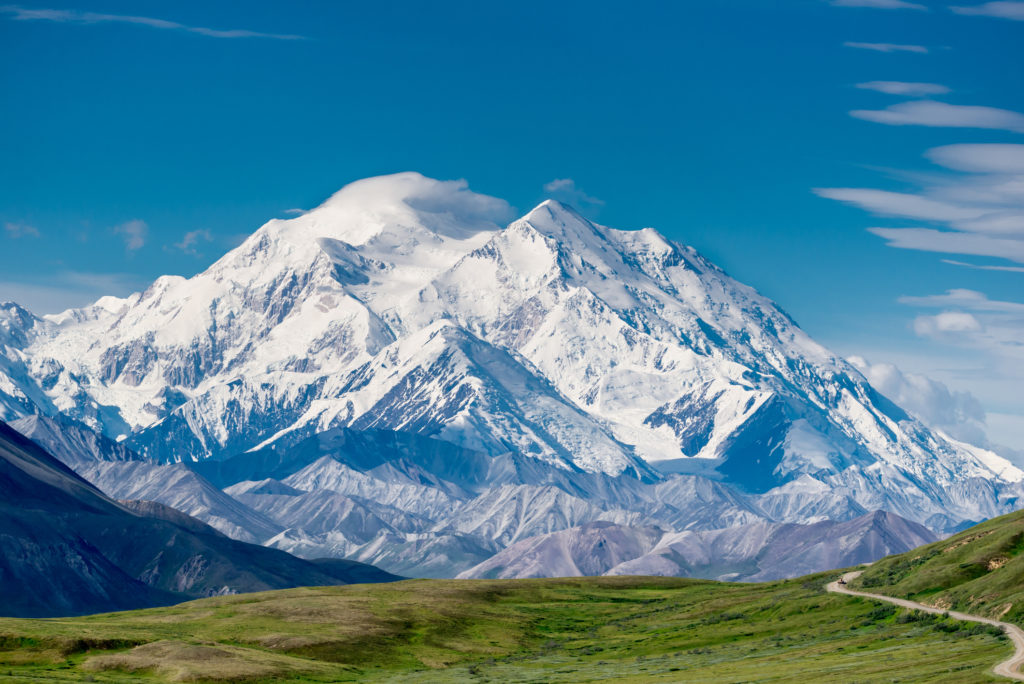
Famous writer and historian, Wallace Stegner once called our national parks, “America’s best idea”. We would agree wholeheartedly! Some of the U.S.’s most amazing landscapes are found in our beloved national parks. Our national parks practically cover every kind of landscape you can imagine–from sandy beaches to active volcanoes, to glaciers and mountain peaks, to rain forests and everglade forests, to desert sand dunes…Our national parks are a treasure and the reason why millions of people from all over the globe want to visit them each year.
Looking for a new national park to explore as a family or want to plan an epic road trip to cover a bunch of national parks? We’ve compiled a list of the top 25 national parks to visit with kids, contributed by top outdoor and family travel bloggers! (*Note: This list is in no particular order.)
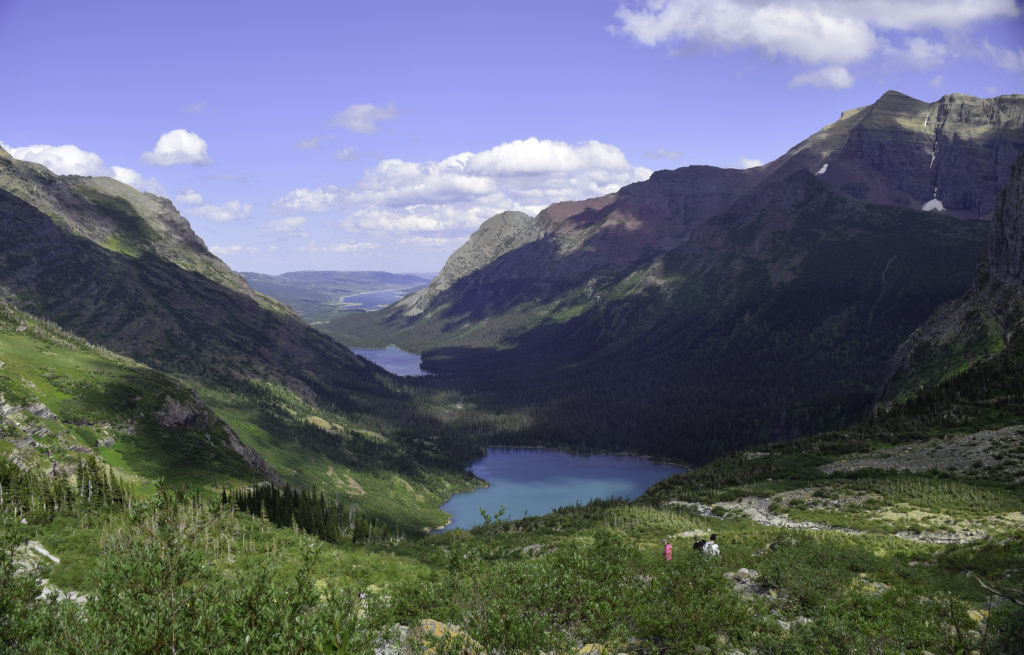
Glacier National Park in Montana is considered the crown jewel of North America.
Located five hours north of Anchorage and just two hours south of Fairbanks, Denali National Park is one of the most popular, and most accessible Alaskan national parks. Made famous for North America’s highest peak, Denali (otherwise known as Mt. McKinley, or the High One), the park is six million acres of mostly road-less terrain, save for a 92-mile dirt road reserved for shuttle buses and permitted private vehicles on their way to a few primitive campgrounds within the park boundaries.
The “real” Alaska is seen everywhere in Denali, from grizzly bears digging for meals within the tundra to herds of caribou wandering near the Park Road, Denali’s magic lies within its remoteness. The entrance area is special, too; families will especially enjoy the easy-to-navigate trail systems any time of year, and a hands-on visitor center provides ample information for curious young visitors with Junior Ranger programs, guided hikes, and backpacks full of interesting tools for exploration available for check out.
Don’t forget to stop by the kennels of the National Park Service’s only canine ranger force, too. The Denali National Park sled dog team is a vital part of winter trail patrols, but in the summertime they are busy snuggling up to visitors during the thrice-daily presentations.
Erin Kirkland is Alaska’s only family travel expert. She is author of the Alaska On the Go guidebook series, and is publisher of AKontheGO.com, a website dedicated to family travel and outdoor recreation.
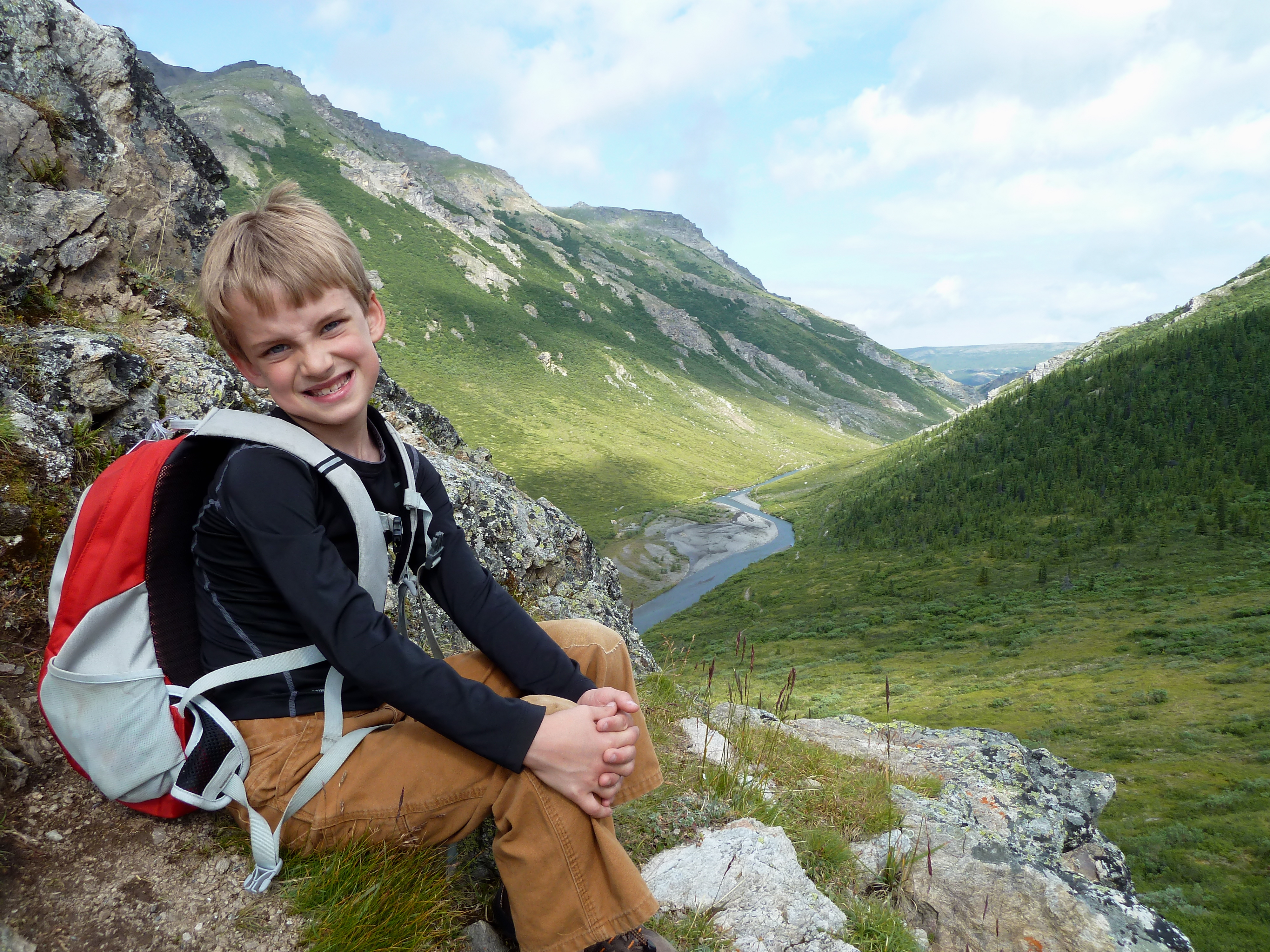
Enjoying the view on a hike in Denali National Park, Alaska. Photo cred: Erin Kirkland of AKontheGO.com
As America’s first national park, Yellowstone National Park is unique for historical reasons along with the diverse natural features that gave this park its nickname in the nineteenth century, “Wonderland.” While parental caution is a must – because of boiling thermal features, steep drop-offs, and a menagerie of wildlife – there is nothing quite like witnessing your child experience their first geyser eruption, watch the Yellowstone River fall hundreds of feet into a canyon, or appear wide-eyed as a heard of bison lazily meander across the road in front of your car.
Highlights in Yellowstone include Old Faithful, Grand Prismatic Spring, Mammoth Springs, and the Grand Canyon. Yellowstone National Park should be on every outdoor family’s list of places to visit. And Yellowstone is a hiker’s paradise with hiking trails accessible to the roads, as well in the backcountry. Make sure to check out Old Tom’s trail, Fairy Falls trail (for the best views of Grand Prismatic Spring), and Mount Washburn trail.
Michael Barton is the author of The Nature Book Nook and runs the Facebook page Children at Nature Play.
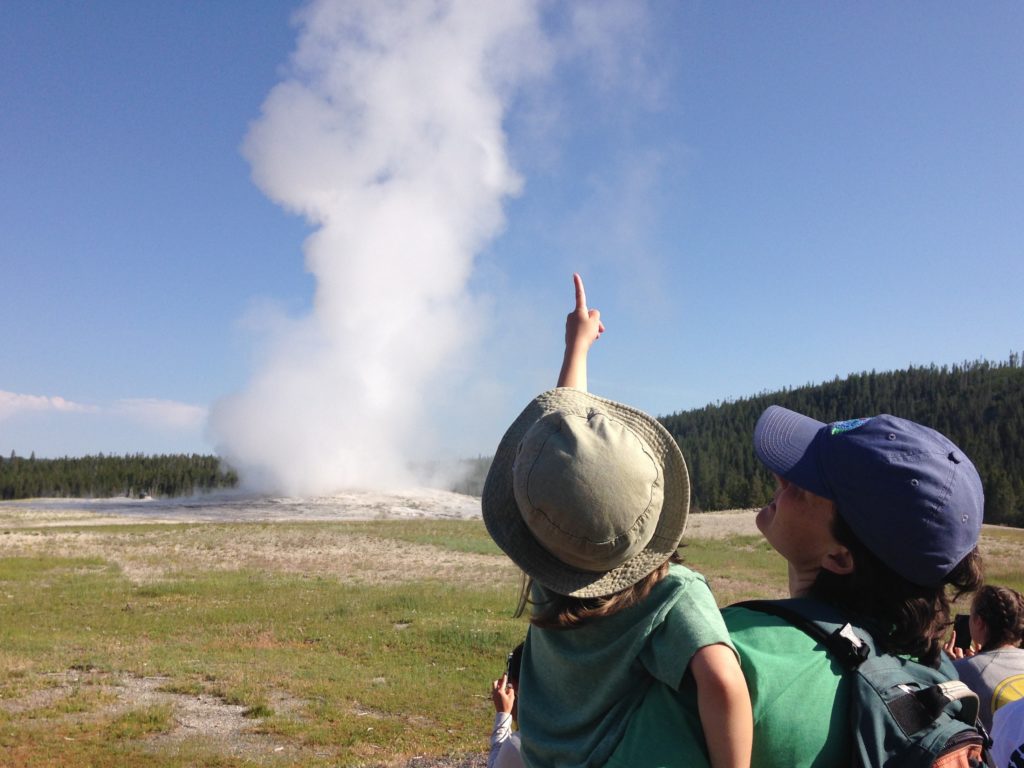
Mom and daughter watch an eruption of the Old Faithful in Yellowstone National Park. Photo cred: Michael Barton
The shades of red, yellow, and orange on the steep rock faces towering over the sparkling blues of the Virgin River that winds its way through the green valley of Zion National Park make this park one of our family’s favorite national parks. Zion offers a wide range of hikes in a small area and almost all the trailheads are accessed only a few steps from the free shuttle bus that takes you into the park’s canyon.
While Angel’s Landing is a must do for those who aren’t scared of heights, I recommend getting an early start because the hike can get really crowded and slow on the section of trail that involves climbing up the chains.
Two of our favorite hikes in Zion are Observation Point and Hidden Canyon (both start at the Weeping Rock Trailhead). The views at Observation Point are epic, however it may be hard to get your kids to hike the 8 strenuous miles. Luckily, there’s another fantastic 3 mile hike where the trail splits right after some switchbacks: Hidden Canyon is perfect for kids and anyone who enjoys scrambling through a tall, slot canyon.
*Extra Bonus: Get a permit and hike The Subway (one of our all-time favorite hikes and pictured below) or The Narrows. After a hard day hiking, rent some inner tubes and float down the river or head into town for pizza and beers at Zion Pizza and Noodle Co. Camping at Watchman or South Campground makes it very easy to access the trails, river, and restaurants in Springdale, as well as quick access to the shuttle bus.
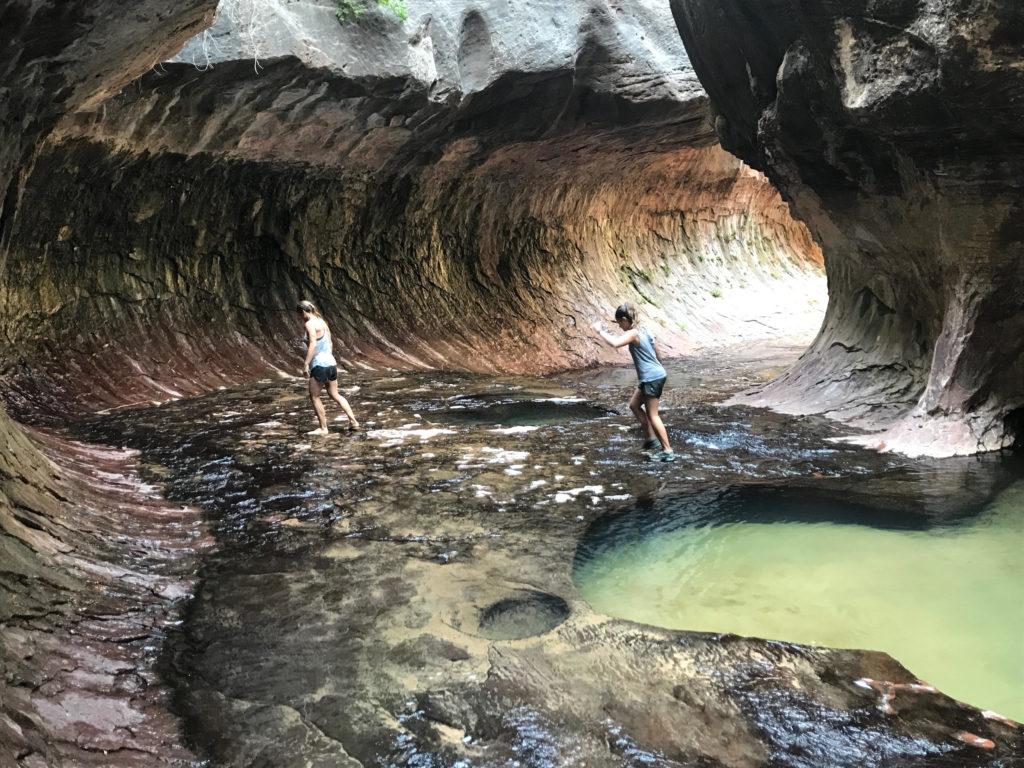
Hiking in The Subway at Zion National Park. Photo cred: Robyn Robledo
Arriving in Death Valley National Park is an experience like no other. The landscape is harsh, intriguing and a little bit surreal. From sand dunes to salt flats, and mountains of every conceivable color, Death Valley constantly changes as you explore further into the park. If you’re there in summer, you’ll soon learn why it’s earned its reputation as the hottest place on earth and you’ll largely stick to a driving tour. However during the cooler months, there are some great walking tracks spread throughout the national park to explore.
Sights worth exploring in Death Valley (and amazing photo opps) include Zabriskie Point, Aguereberry Point, Dante’s View, and Artist’s Palette (also known as Artist’s Drive). Also, don’t miss hiking the Mesquite Flat sand dunes, Badwater Salt Flats (both easy hikes), and Mosaic Canyon.
Nicci O’Mara is the founder and editor at Trip Chiefs, where she writes about great destinations and adventures to take boys.
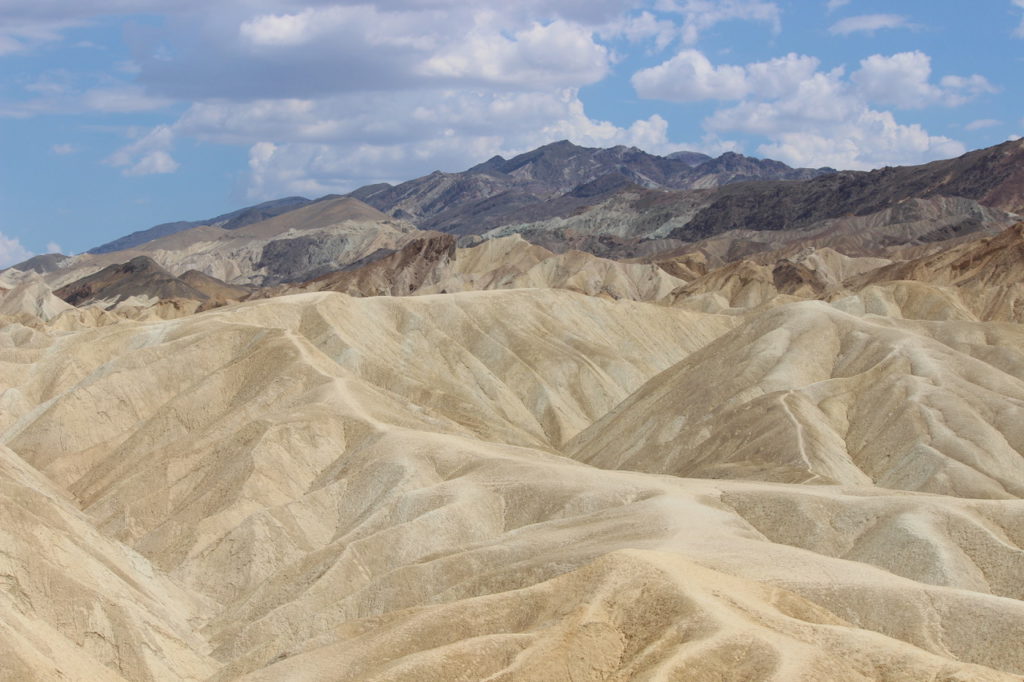
Death Valley National Park captured from Zabriske Point. Photo cred: Nicci O’Mara
If you ask the kids what they love most about Rocky Mountain National Park, they’ll each have a different answer. One will tell you it’s the wildlife: the elk, deer, and magpies that can be spotted all over the park. Another can’t pass up the exciting drive along Trail Ridge Road, the highest continuous paved road in the US. Our oldest will tell you the hiking is the best. Bear Lake trail is a favorite kid-friendly hike.
Although it’s a heavily trafficked trail, in the winter months the lake freezes over and you can walk on the lake! And while you’re there in those colder months, bring your sleds and stop by the Hidden Valley area for a few runs down the tubing hill. Year round, be sure to check out the Youth & Family programs offered by the Rocky Mountain Conservancy.
Many of these expert-led programs are free for kids, and is an amazing opportunity to learn about the park environment and activities to do within the park. If you’re not staying the night at one of the park campgrounds, then end your RMNP visit in nearby Estes Park. Restaurants, shopping, or a visit to the historic Stanley Hotel is a perfect end to a day in the Rockies.
Kiersten Einsweiler is a blogger and founder of Hiking In My Flip Flops and can also be found on Instagram.
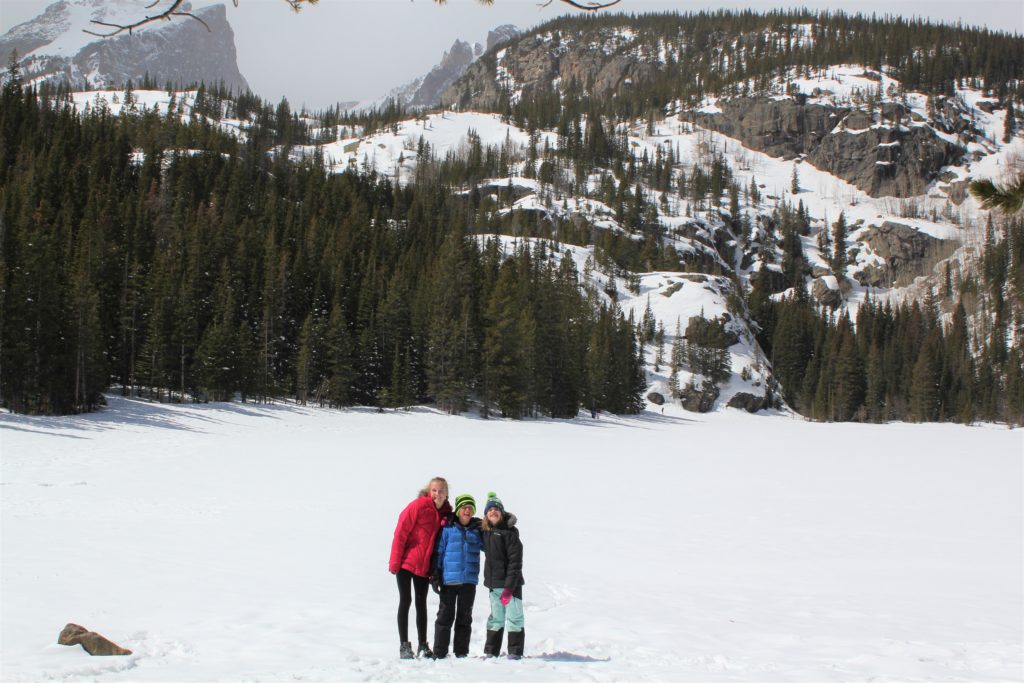
Enjoying the winter wonderland at Rocky Mountain National Park, CO. Photo cred: Kiersten Einsweiler
Visiting Hawaii Volcanoes National Park was at the top of our “must-do” list while vacationing on the Big Island. One of our favorite activities was hiking across a crater along the Kilauea Iki Trail. We started at the trailhead along the Chain of Craters road in a lush jungle. Once we started the descent into the crater, the landscape quickly changed from tropical rain forest, to barren rock garden.
The trail across the crater felt like we could have been on the moon! We also visited the Kilauea Caldera Overlook at night, drove the Chain of Craters road, explored the Thurston lava tube, and witnessed the flowing lava. Finding the surface lava included a 4 mile bike ride and a 1.5 mile hike (no small feat for kids!), but it was so incredible to be near such a powerful force of nature!
Jess Curren and her airstream-living, outdoor-loving family, blog about their adventures and travels at Currently Wandering and can also be found on Instagram. Read more details on their trip to the Hawaiian Volcanoes National Park.
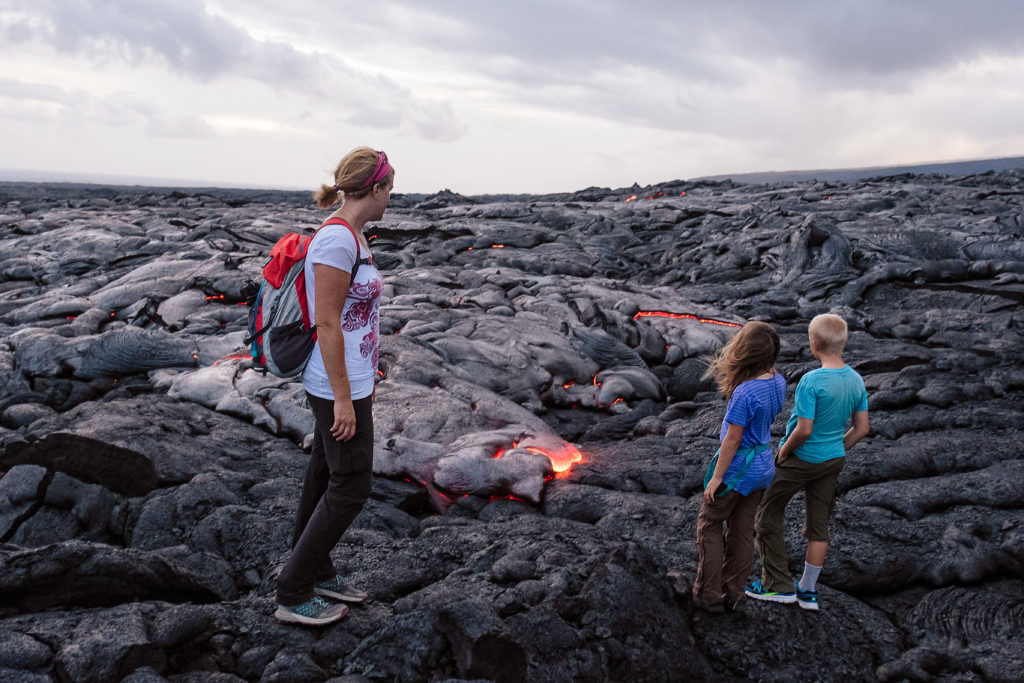
There’s nothing like seeing hot lava up close and personal at Hawaii Volcanoes National Park. Photo cred: Jess Curren
There’s no place quite like Northern California, specifically the Redwood Forest National Park. It’s a great place for kids to experience a unique side of nature, hiking and climbing around the 2,000 year old trees. As you hike among the massive trees you feel as if your exploring another planet. Standing next to these towering trees will make you feel small, but at the same time leave you feeling at peace.
You may feel like an Ewok or think a T-Rex may jump out at any moment because Star Wars “Return of the Jedi” and Jurassic Park “Lost World” had scenes filmed in this magical national park. That’s why it’s our favorite national park! There are so many great hikes and trails in the Redwoods, but a few noteworthy ones are Fern Canyon (otherwise known as James Irvine-Miner’s Ridge Loop), Redwood Creek trail, Lady Bird Johnson Grove, and Boy Scout Tree trail.
Dylan Myers is a family travel blogger at Family Travel Go where you can find more information on their trip to the Redwood National Park. You can also follow their family travels and adventures on You Tube.
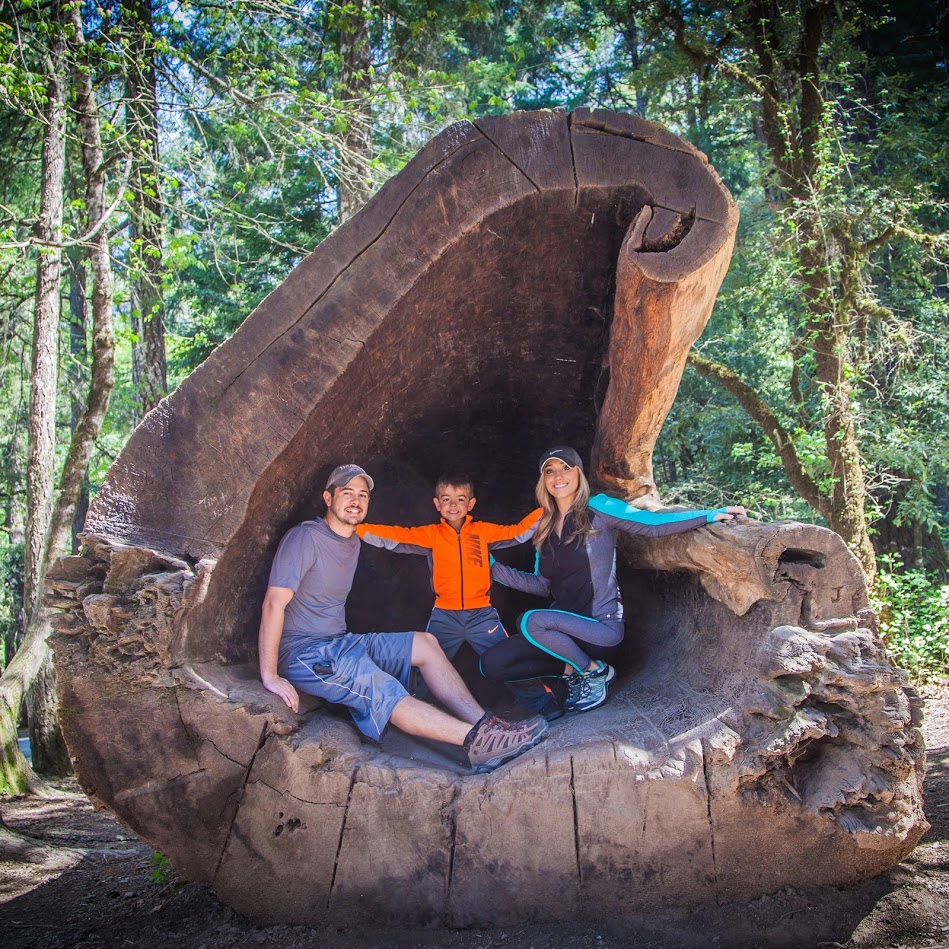
Climbing inside a giant, ancient Redwood tree is a pretty surreal experience. Photo cred: Dylan Myers
The first national park formed east of the Mississippi River, Acadia National Park, boasts 125 miles of hilly or mountainous hiking routes ranging from easy to strenuous, and the views from the seaside trails, in particular, are truly magnificent. Gorham Mountain trail, our family’s favorite, begins just past Thunder Hole on the right. Follow this moderately difficult path up the south side of the mountain, ascending through Cadillac Cliffs, scrambling through the caves, and arriving at the magnificent views of the 525-foot Gorham Peak.
Once at the top, you can turn around and complete the 1.8 mile loop or continue down the north side of the mountain to cool down at the Bowl, a fun swimming lake. If you want to eat your weight in fresh Maine lobster, Thurston’s Lobster Pound is a must-stop while in the park, or stop in at Jordan Pond House for yummy popovers and take any easy stroll around Jordan Pond nature trail where you’ll find crystal clear waters perfect for exploring a skipping rocks.
Jennifer Fontaine is a health, wellness, and family travel expert and founder and managing editor of Outdoor Families Magazine.
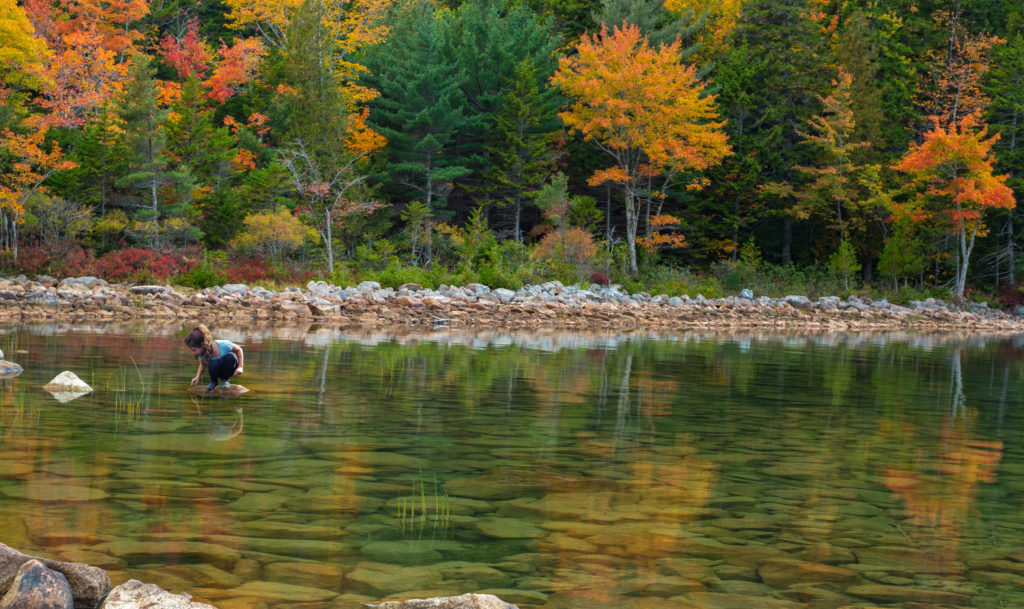
Fall is arguably the most beautiful time of year to visit Acadia National Park in Maine. Photo cred: Kerem Hanci
The National Park of American Samoa is the only national park south of the equator. The park is spread across three islands in the South Pacific, with 9,000 acres of land and 4,500 acres of coral reef and ocean. Two of our favorite hikes are the trail to Mt. Alava, which runs along the top of the ridge of Tutuila Island, with sloping views down to the ocean on both sides; and the World War II Heritage Trail, which takes you past old World War II gun emplacements.
Both trails have different length options, making them great for any age. The beaches are mostly untouched and usually empty, so you have room to explore or relax. From lush tropical rain-forests, to an underwater wonderland, the National Park of American Samoa is a family adventure just waiting to happen. If you ever make it to the South Pacific, be sure to check out this jewel!
Melinda Clayville is a family travel blogger at Traveling Outside the Box, where they write and share about their often unconventional travels while living in American Samoa. You can also read more about their lives residing in American Samoa.
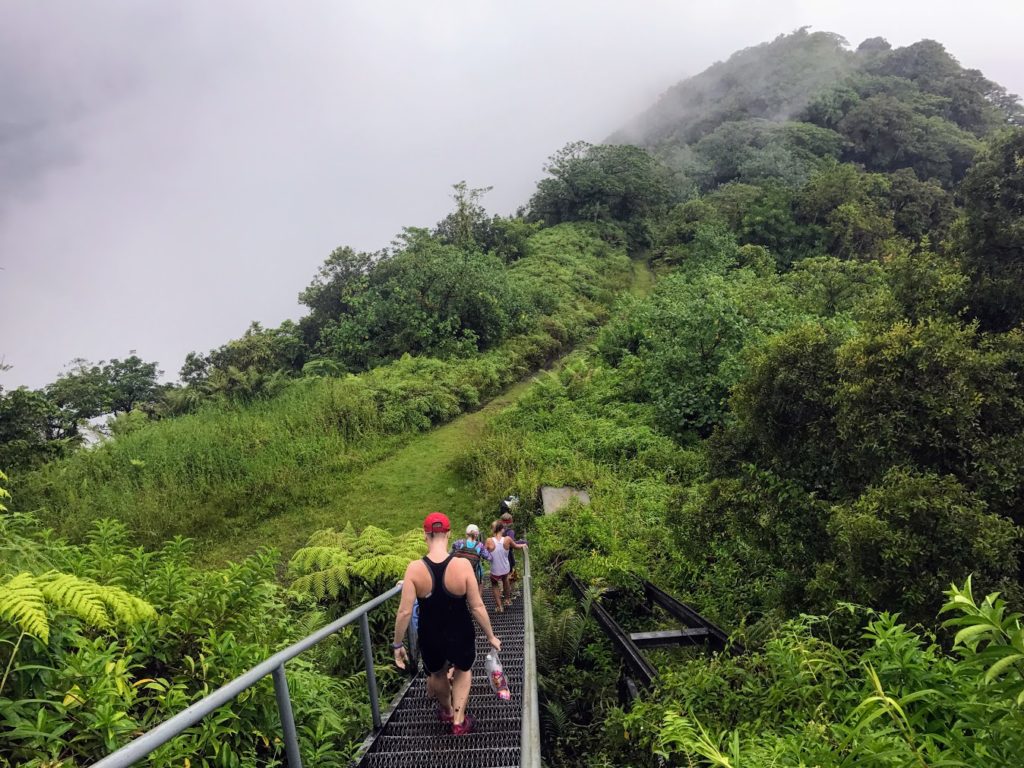
Exploring one of the many hiking trails along the American Samoa National Park. Photo cred: Melinda Clayville
South Dakota’s Badlands National Park is part scenic wonder and part world’s best playground. You won’t find any signs warning to you to keep out of certain areas; you and your kids are free to explore off trail and climb buttes to your heart’s content. The Door Trail starts out with a short boardwalk and some great views, and then you can keep on exploring after the maintained trail ends, following yellow paint marks deeper into the Badlands.
The Notch Trail requires a climb up a log ladder on the side of a cliff; I don’t normally get along so well with heights, but I made myself do it and was rewarded with more great views and a sense of accomplishment (tempered a bit by the fact that my four year old made the climb, too). Aside from hiking and climbing, there’s a great visitor center, a full schedule of ranger programs, and a scenic drive through the park with lots of great wildlife spotting (some of the highlights for us were spotting Bighorn sheep and prairie dogs).
Gretchen Holcombe writes about their family RV travels at Boxy Colonial On the Road, and you can read more about their visit to Badlands National Park on their blog.
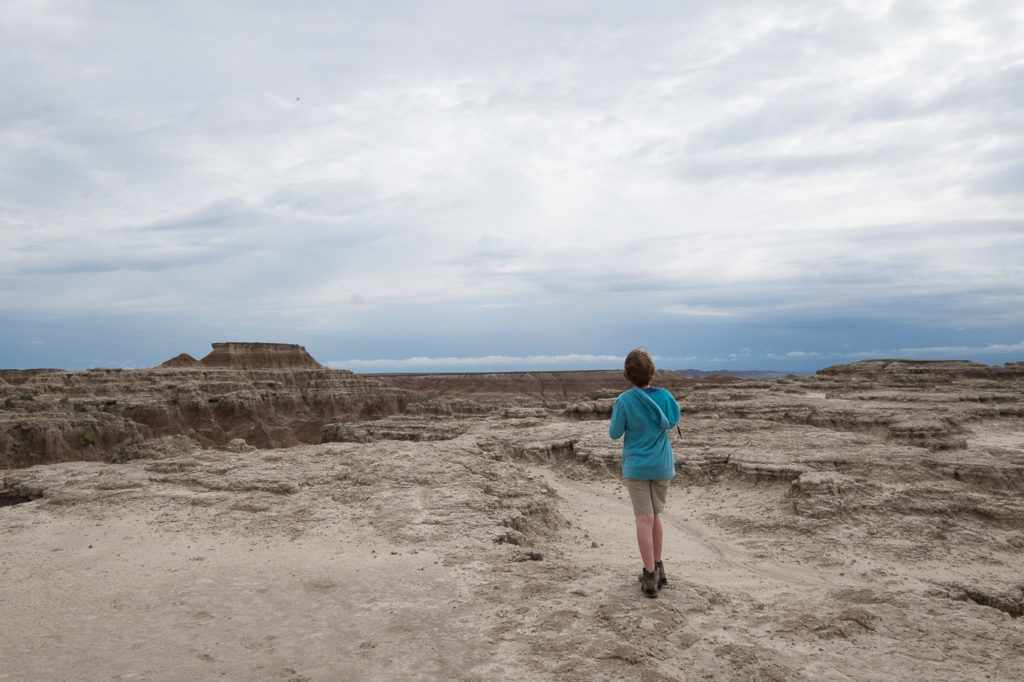
Wandering through Badlands National Park is a unique experience. Photo cred: Gretchen Holcombe
Arches National Park is home to the iconic Delicate Arch, but what people don’t often know is that the entire park is a nature-made playground for kids. Most of the hikes to the natural rock formations are between .25 and 5 miles round trip, making them very accessible for families with young kids. And while the awesomeness of these unique rock formations is often lost on kids, scrambling over sandstone, playing in fine orange sands, and spotting tiny lizards make this one amazing place to visit for families! Our favorite hikes in Arches include Delicate Arch, Double O Arch, and Black Angel Arch.
Alyssa Erickson is an outdoor enthusiast based in Utah and blogger for Kid Project, where she writes about the best outdoor adventures for kids in Utah and beyond, as well as gear reviews. You can read more about their favorite hikes in Southern Utah or follow their family adventures on Instagram.
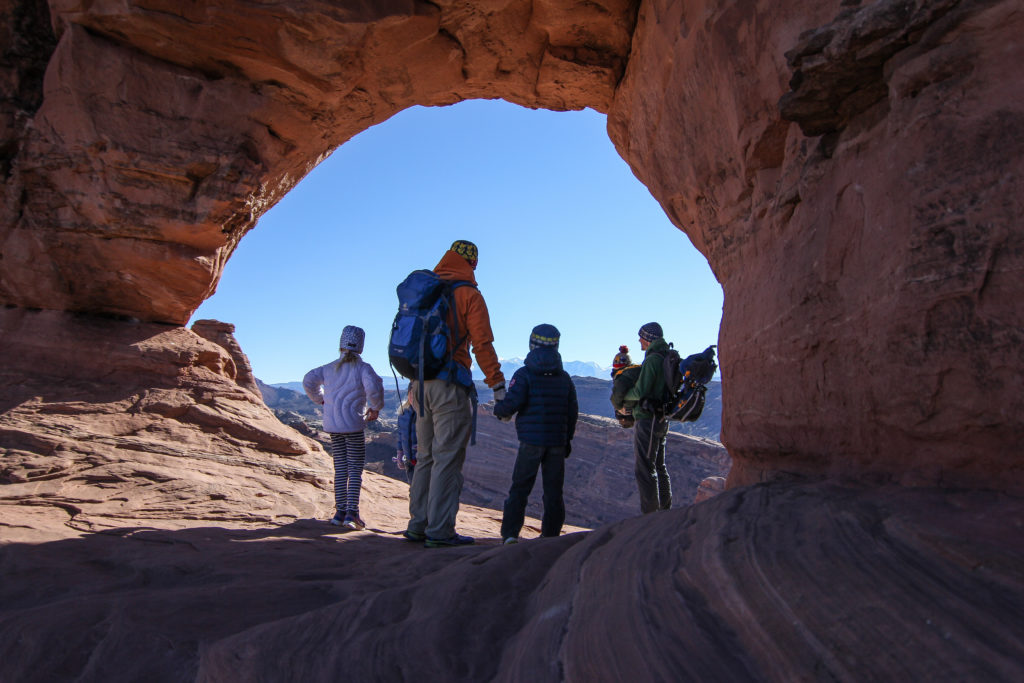
You can’t beat the views along the trail to Delicate Arch in Arches National Park, UT. Photo cred: Alyssa Erickson
Mount Rainier National Park includes over 12,000 feet of vertical relief from the dense rain forests to the barren, glaciated summit. In between are adventures suitable for everyone from kids in backpacks to teens that think they’re invincible. Each season provides unique opportunities whether snowshoeing in winter or strolling through brilliant fields of wildflowers in summer. The hike to Second Burroughs from the Sunrise Visitor Center is one of the best in the Park, but only available for a few short months during the summer. The summit puts you face to face with the upper Mountain, but even if you don’t go all 4.5 miles to the top the views will astound you, reminding you there’s a lifetime of adventures on Mount Rainier so neither you nor the kids will ever get bored.
John Soltys and his family reside in the Pacific Northwest, where he writes for Moose Fish and provides tips for outdoor adventures in beautiful Washington. Make sure to read his guide for adventures on the east side of Mt. Rainier for more ideas on what to do in Mount Rainier National Park.
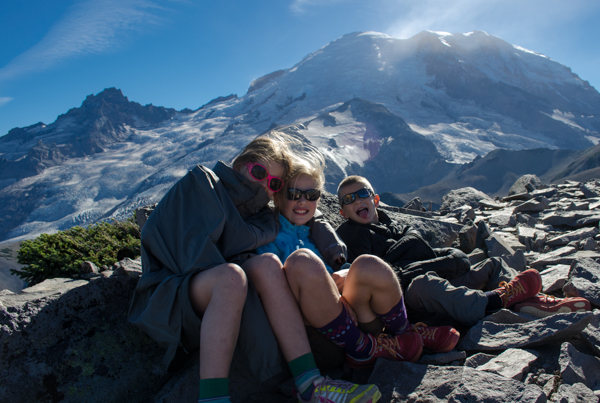
It’s hard to believe that Mt. Rainier is covered in glaciers! Photo cred: John Soltys
When we are looking for a family adventure, we tend to stay away from crowds and get off the beaten path, especially if we are visiting a national park. We love to dive into the history of the area and spend our time soaking up the natural beauty that surrounds us. Voyageurs National Park has more than 340 miles of navigable waters and 600 miles of rocky shoreline, making any water-based activity the highlight of your time in this National Park.
This is a park that I not only grew up going to every summer, but now have the opportunity to share it with my own children. Motorized boats are allowed in Voyageurs, unlike the neighboring and more rustic Boundary Waters Canoe Area Wilderness. Boating, canoeing, kayaking, swimming, fishing and hiking can fill your days while visiting this hidden gem. Swimming in these gorgeous lakes is by far our favorite daytime activity and marveling at the star filled sky from our campsite makes nights just as enjoyable.
If you’re lucky, you may even fall asleep to the sound of wolves. The lakes offer the chance to spot a variety of wildlife, including a few Minnesota mosquitoes! Many people rent houseboats to travel through the connected lakes, but there are also more than 200 campsites, only accessible by boat. Be sure to enroll your children in the Junior Rangers program, by picking up materials at one of the three visitors centers that are spread across the park.
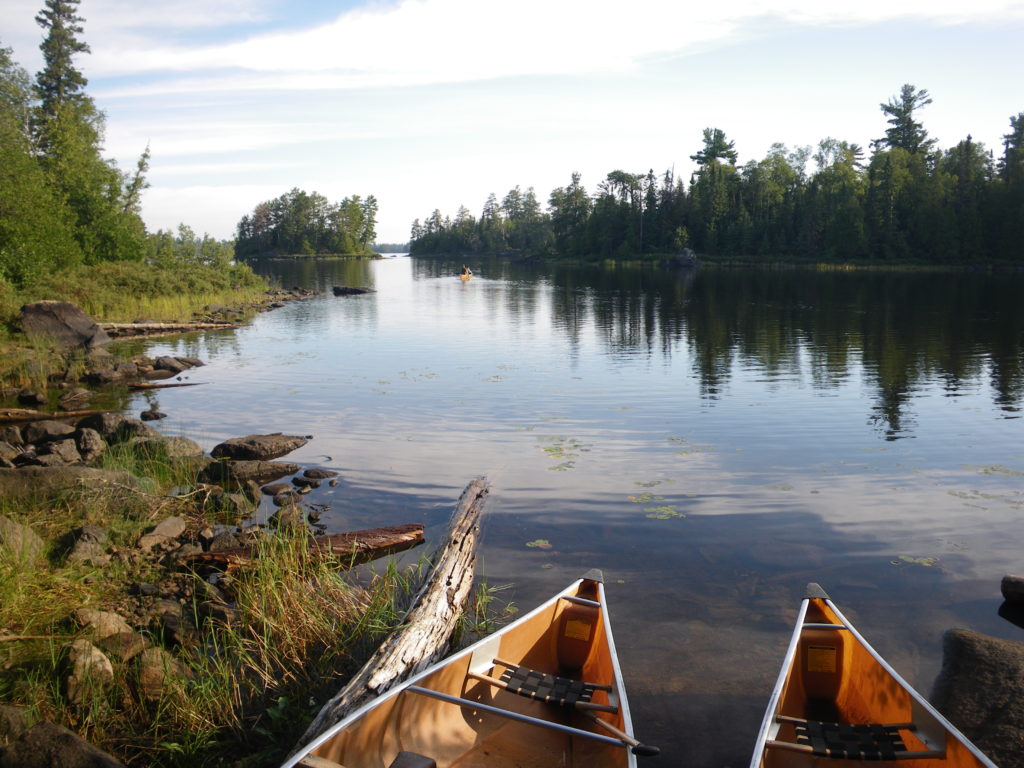
Canoeing along the shoreline of Voyageurs National Park in Minnesota and finding boat access-only campsites is a unique experience while visiting this national park. Photo cred: Kayla Keigley
Kayla Keigley is a family travel blogger at Wanderlocity residing in the Pacific Northwest, where she writes about all things adventure for little ones off-the-beaten-path. You can also follow their adventures on Instagram.
Joshua Tree National Park is a great park for all ages – and one of our favorites! For young kids, there are easy trails and endless open spaces to run around. Older kids can enjoy more strenuous hikes and there are plenty of giant boulders to climb and explore. For more adventurous families, give rock climbing a try on a number of the massive rock structures. Cholla Cactus Garden (go at sunrise!), Arch Rock, and Cottonwood Springs are a few of the best hikes Joshua Tree has to offer. Also, keep in mind that Joshua Tree is a desert, so you’ll find very hot summers and cold winters. Spring and fall are the best time to visit, but it’s worth the trip any time of year. Make this one a camping trip too for some of the most incredible stargazing.
Laura Gibbons is a travel blogger with Let’s Go Little One, where she writes about their family travels with a focus on culture, courage and education to encourage families with young kids to explore the world around them. You can also follow Laura on Instagram where she documents their beautiful adventures.
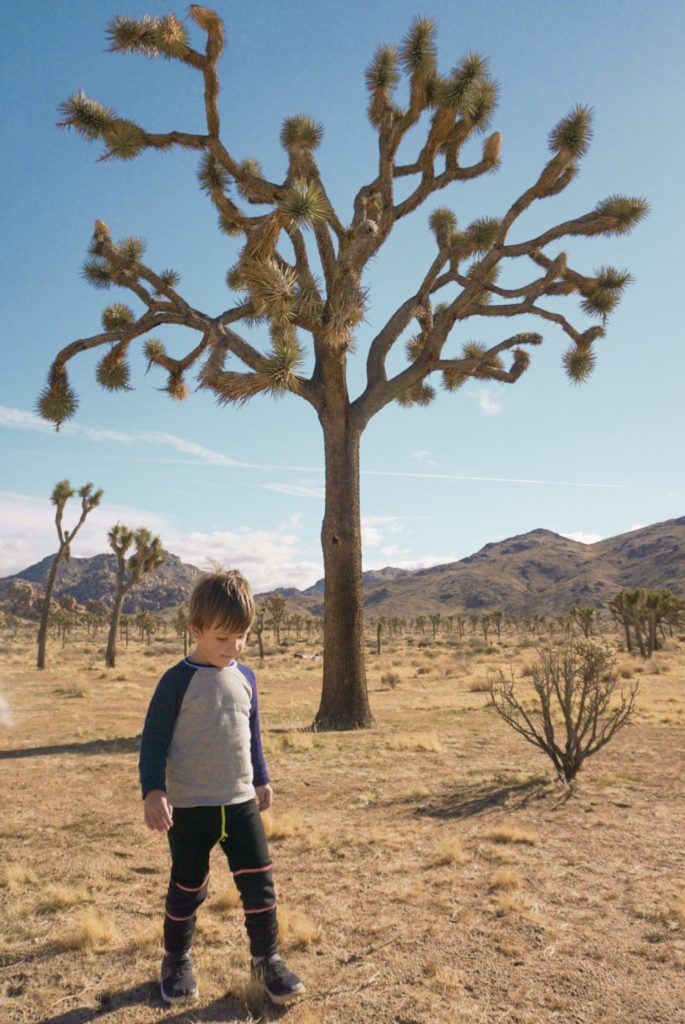
Running free in Joshua Tree National Park is big perk for visiting this park with kids. Photo cred: Laura Gibbons
While Grand Teton National Park is known for it’s rugged mountains and awe-inspiring scenery (and incredible athletes who conquer both!), it’s also my favorite place for families, even with young kids. We are lucky enough to live here with our 5 kids aged 9 and under, but recommend it for anyone, no matter how adventurous you consider yourself! There are an abundance of short hikes that allow incredible views, miles of paved bike paths, quick access to water sports (via the alpine lakes and rivers) and lots of wildlife to keep kids looking.
Also, the town is close so when you need a break or the weather comes in, it’s easy to bail quickly! Our favorite hike is Taggart Lake because the views are incredible, the 5 mile trail is kid-approved and the scenery changes often to keep interest. But, go early in the day or in the Fall to avoid big crowds! Read more tips on visiting Grand Teton National Park and Yellowstone in the Fall.
Find Amelia on her blog, Tales of a Mountain Mama, or follow their outdoor adventures on Instagram.
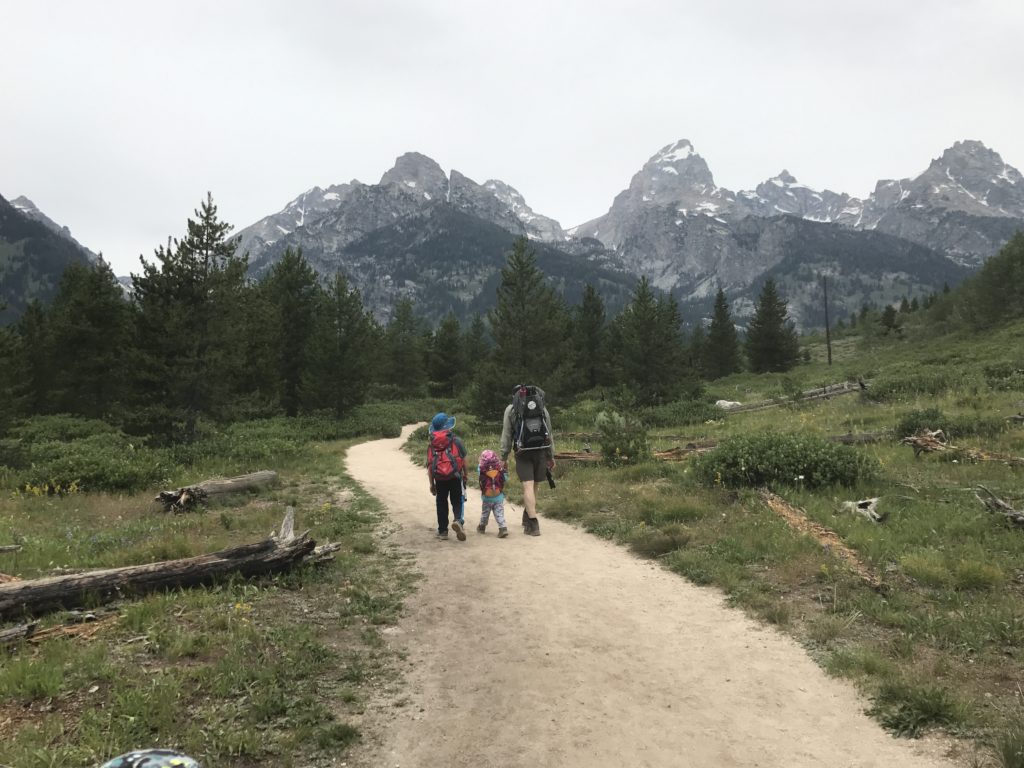
Hiking one of many great trails for kids in Grand Teton National Park, Wyoming. Photo cred: Amelia Mayer
Bryce Canyon National Park is one of our favorite national parks because of its unique geology, its breathtaking vistas, and its fun trails to explore with kids. There is nowhere on Earth like Bryce! Walking among the giant hoodoos on the Navajo-Queens Garden Loop is something out of this world, cooling off at Mossy Cave is a must in the hot summer months, or for a different kind of adventure, horseback riding along the Fairyland trail. You also can’t come to Bryce without catching the sunrise from the Rim Trail (pictured below).
Most people try to avoid the desert in the heat of summer, but Bryce has the advantage of being at above 8,000 feet, so it doesn’t get as sweltering hot as some of the other parks in Utah and Arizona in the summer time. *Tip: Don’t rule out visiting Bryce in the winter months. With the lack of crowds and ability to witness the hoodoos covered in snow, going in Winter is worth the trip!
Read more in-depth details to include best hikes in Bryce, other things to do in Bryce with kids, as well as camping tips in our post, Bryce Canyon National Park with Kids.
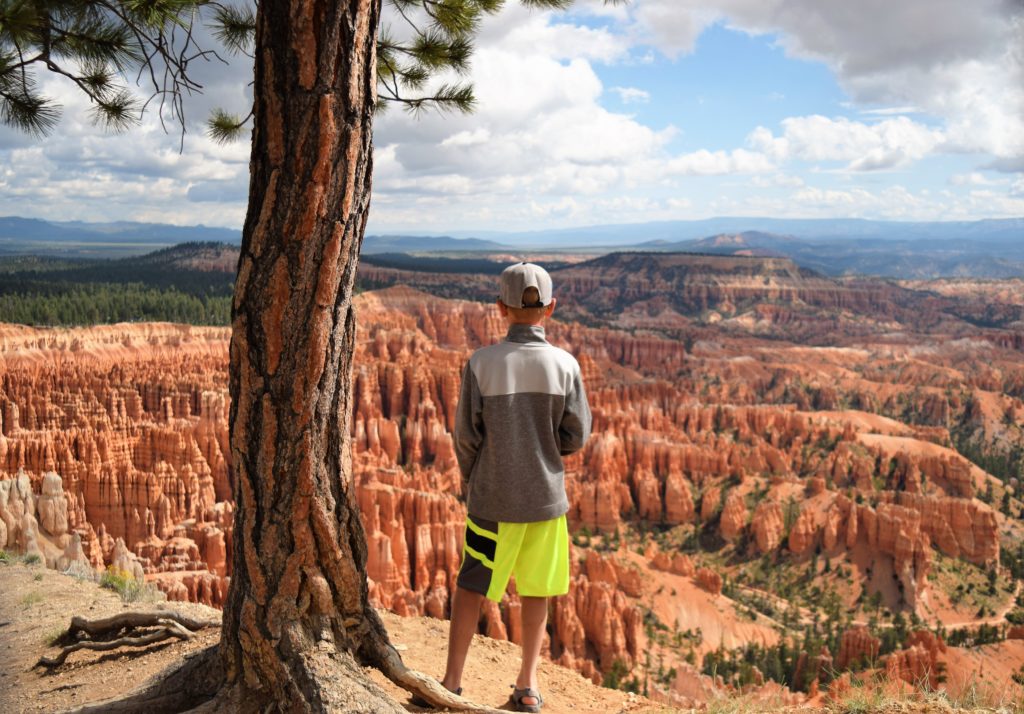
The views from the Rim Trail at Bryce Canyon will leave your jaw on the ground.
The Dry Tortugas are a remote National Park located 60 miles off the coast of Key West. To get there you can charter a boat, take a seaplane, or come over on a ferry. The ferry was the cheapest option for our family of 5 by far ($165 per adult), and since we were already paying to go out, we decided we might as well camp for a few nights while we were there! The small island has beautiful sandy beaches, snorkeling right off the beach along the fort walls and the pier, dark night skies, amazing sunrises, and a historic fort just waiting to be explored. Dry Tortugas has some of the best snorkeling in the United States! There are primitive camping options on Dry Tortugas, but you can also stay in one of many hotels. It was by far one of our favorite family vacations!
Jess Curren and her airstream-living, outdoor-loving family, blog about their adventures and travels at Currently Wandering and can also be found on Instagram. Read more details on their trip to the Hawaiian Volcanoes National Park.
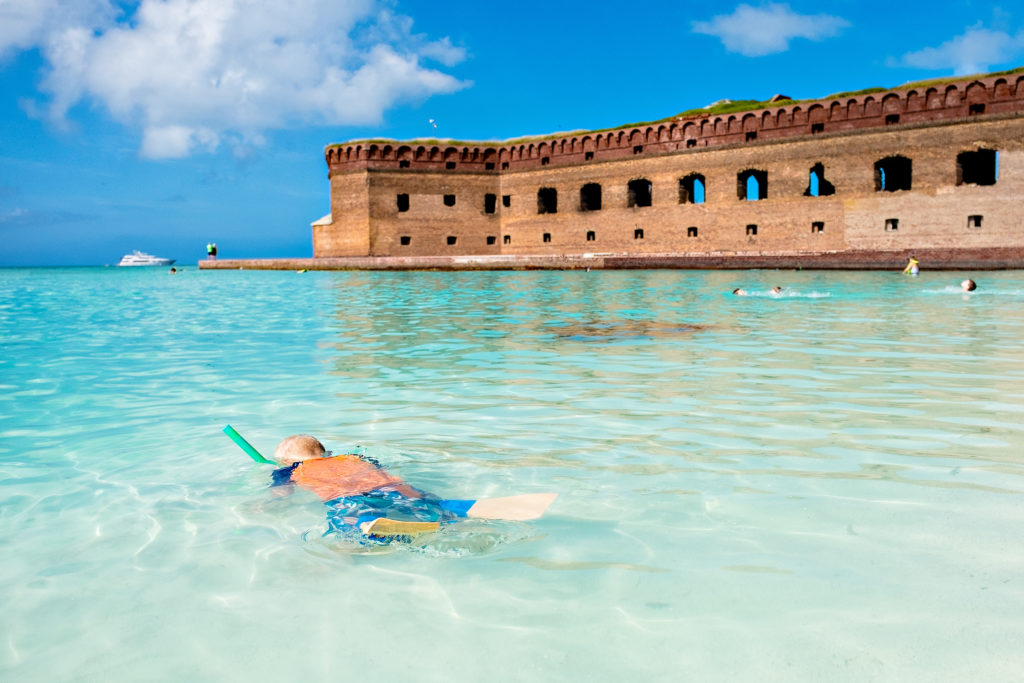
Snorkeling in Dry Tortugas National Park will be a vacation your kids will never forget. Photo cred: Jess Currren
The Great Smoky Mountains National Park offer families endless opportunities for outdoor adventure any time of the year. From family-friendly hikes to playing in streams or just taking in the beauty while driving from Tennessee end to North Carolina, you’ll never be bored here. Our favorite hike and probably the easiest in the entire park is located just behind the Sugarloaf Visitor Center. Bring your bathing suits and let the kids play in the creek to cool off. Laurel Falls is another great hike, although it’s best suited for families with older kids or smaller children in backpack carriers due to the large cliff you walk along at the top.
The journey to the waterfall at the top is well worth it though. As you’re driving through the park be sure to stop at the Newfound Gap for stunning views and a fun photo opp while standing in two states at the same time. Another point to stop at is Clingmans Dome, which is the highest point in the Smoky Mountains. It’s a short but steep hike up, suitable for all ages. Don’t miss the Oconaluftee Visitors Center on the North Carolina end of the park as it’s full of history and the historic buildings are quite fun to walk through.
Brittany Kollmer shares her family travels at October Acres and also runs an online jewelry shop called B Stamped.
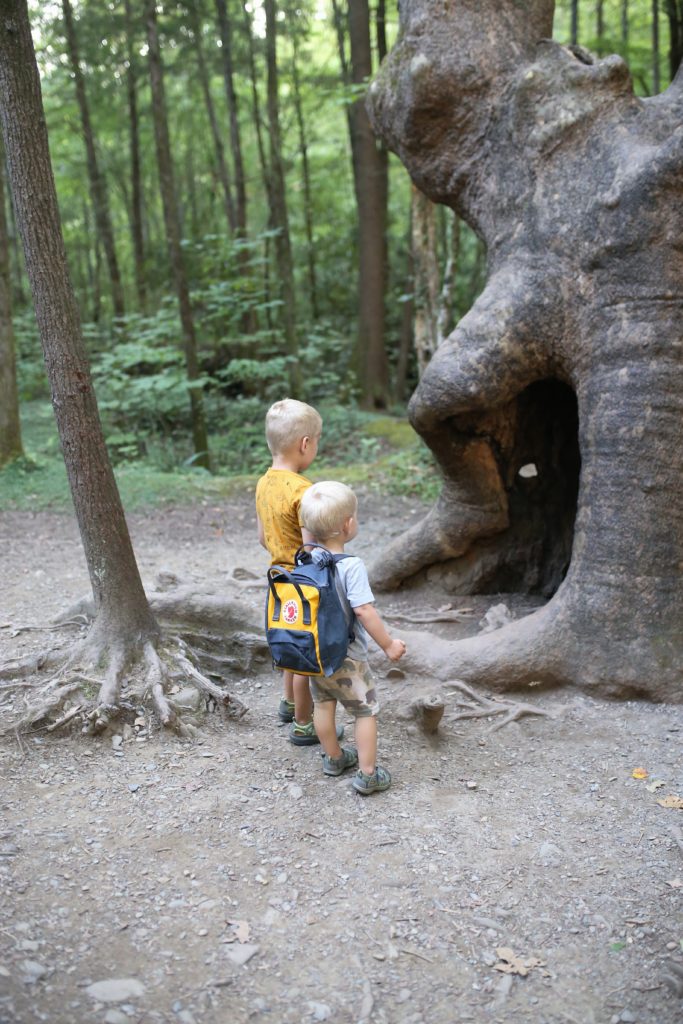
Checking out the cool trees at Smokey Mountain National Park, Tennessee. Photo cred: Brittany Kollmer
Big Bend National Park is our favorite national park that we’ve been too (over the course of a year-long road-trip we’ve been to a lot). The national park, and nearby Big Bend Ranch State Park, offer endless opportunities for kid-friendly outdoor recreation. As part of the Junior Ranger program, kids can earn 3 different supplemental patches for hiking within the park. The intermediate hike takes you to a natural hot spring on the banks of the Rio Grande River. There are lots of other great day hikes within the park. Another junior ranger activity has you discover the night sky. The park rates as a Class 1 location on the Bortle Scale, meaning that it is one of the best places anywhere to stargaze. Finally, just outside of the park in Lajitas, TX, there is a great system of family-friendly mountain bike trails.
Follow Kristen Bonkoski and family at Rascals on the Road as they travel across the U.S. in search of the best singletrack, and also on a mission to get more families on bikes. You can also find all your questions to what kind of bikes and gear to get your family at Rascal Rides.
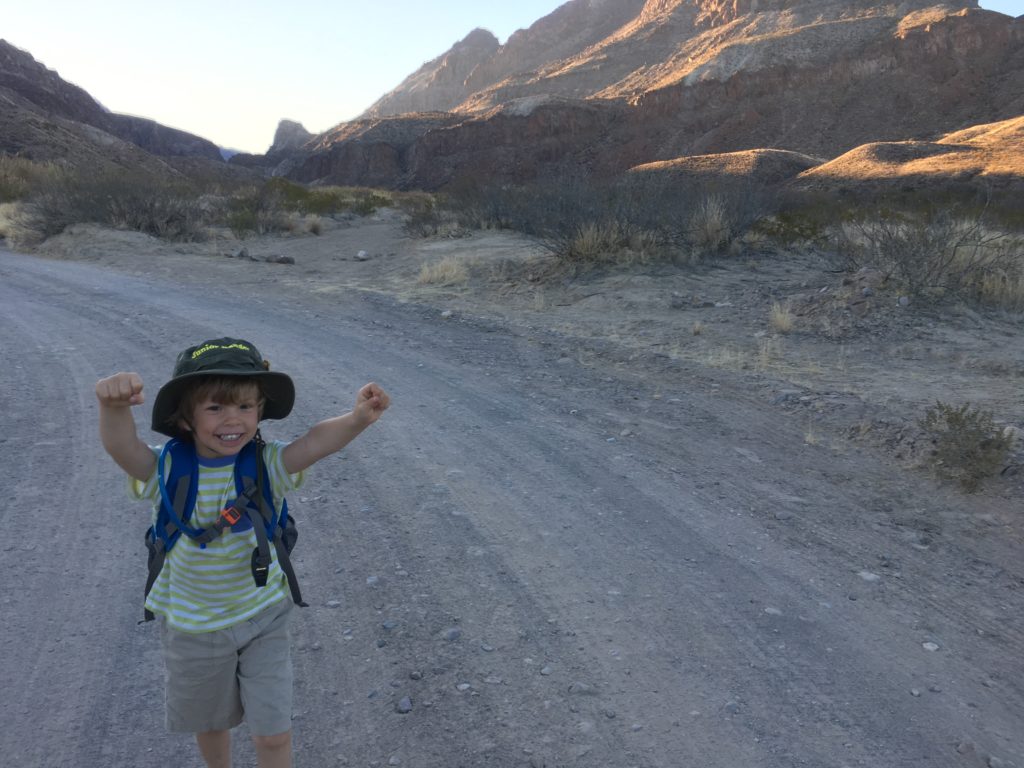
Hiking in Big Bend National Park, Texas. Photo cred: Kristen Bonkoski
A visit to Yosemite National Park is the quintessential family adventure. In Yosemite, you are surrounded in nature, experiencing it all, not just observing it. The beauty of Yosemite extends beyond the natural surroundings in that it offers a wide range of accommodation options, hikes and activities to please all types of families. If there is only one thing you do at Yosemite, it should be traversing the 12 miles of gorgeous bike paths that cross the valley. And if you have little ones, don’t worry, you can rent trailers to pull them along. It is here that you will get away from the crowds so that you can fully experience the land as John Muir once did. And as a bonus, you just might see snakes, bobcats, deer and bears too!
With an abundance of hikes available, its difficult to choose just which one (or 12) to do. For one of the best views, head to Glacier Point (most often closed in the winter months). You can hike here or just take in the vista. Younger kids will love a visit to the Happy Isles Nature Center for a ranger led hike or to just check out their awesome poop exhibit. Lastly, one of the best hikes in the park, in our opinion, is the Mist trail to Vernal Falls, an uphill hike with a cool payoff. Whether you camp, stay in tent cabins or in a hotel, spending time in Yosemite will provide you ample opportunities to replenish, refresh and rejuvenate.
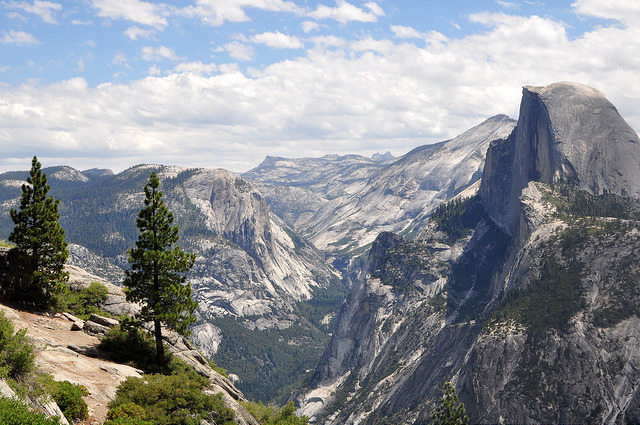
The view of Half Dome from Glacier Point in Yosemite National Park is truly memorizing. Photo cred: Karilyn Owen
Karilyn Owen is a family travel blogger at No Back Home, residing in California and traveling with her son all over the world as often as they can. You can also find them on Instagram and get more Yosemite recommendations on their Ultimate Guide to Yosemite.
Thanksgiving spent at the Grand Canyon is our family tradition. This tradition began when our sons were in grade school and I was tired of cooking and we wanted to make special memories together over the holiday. In our opinion, each visit to Grand Canyon National Park is special, unique and never disappoints. Seeing the Canyon for the the first time will take your breath away no matter how old you are and no matter how many photos you’ve seen.
The Canyon is mesmerizing. We enjoy hiking along the paved Rim trail on the South Rim (the North Rim is closed in winter) or on the famous trails below the rim such as Bright Angel and South Kaibab. When our sons were 11 and 13, we backpacked to Phantom Ranch at the bottom of the Grand Canyon. Starting out at the top, the weather was cold and the leaves had fallen from the trees. By the time we hiked to the bottom, losing nearly 5,000 vertical feet over 6.3 miles, we’d traveled back in the seasons to late summer, with warm temperatures and green leaves clinging to the Cottonwood trees.
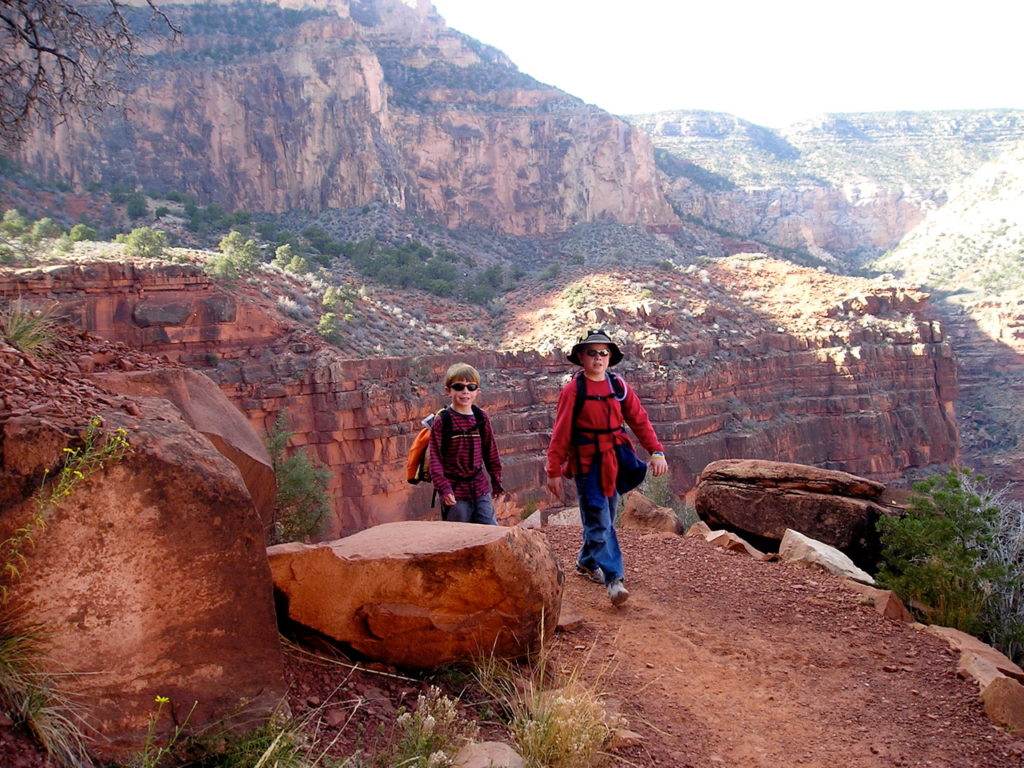
Hiking one of the Rim trails at Grand Canyon National Park. Photo cred: Kristen Lummis
Kristen Lummis is blogger for Brave Ski Mom and freelance writer based in Colorado, where she writes about family skiing, outdoor adventure and healthy living. Read more about their Fall hiking adventure to the Grand Canyon.
Did you know that Everglades National Park in Florida is the largest subtropical wilderness in the U.S.? It is also home to the endangered manatee, Florida panther and American crocodile. The Everglades is also a World Heritage site. For families, it is a great national park to learn about and spot all the different species of wildlife here, and there are also a variety of activities fitting for children, such as taking a swamp boat tour or kayaking through the mangrove trees of the swamp.
If you are really up an adventure, you can canoe or kayak the Wilderness Waterway, which is 99 miles long and takes approximately 7-10 days to complete. There are also ample bike trails to explore in the park, and if you love hiking and camping, you won’t get bored in the Everglades. Fishing is also a popular activity in this national park (keep in mind there is limited shoreline fishing here), and you can even charter a fishing guide for a day if you really want to experience fishing at its finest within the park.
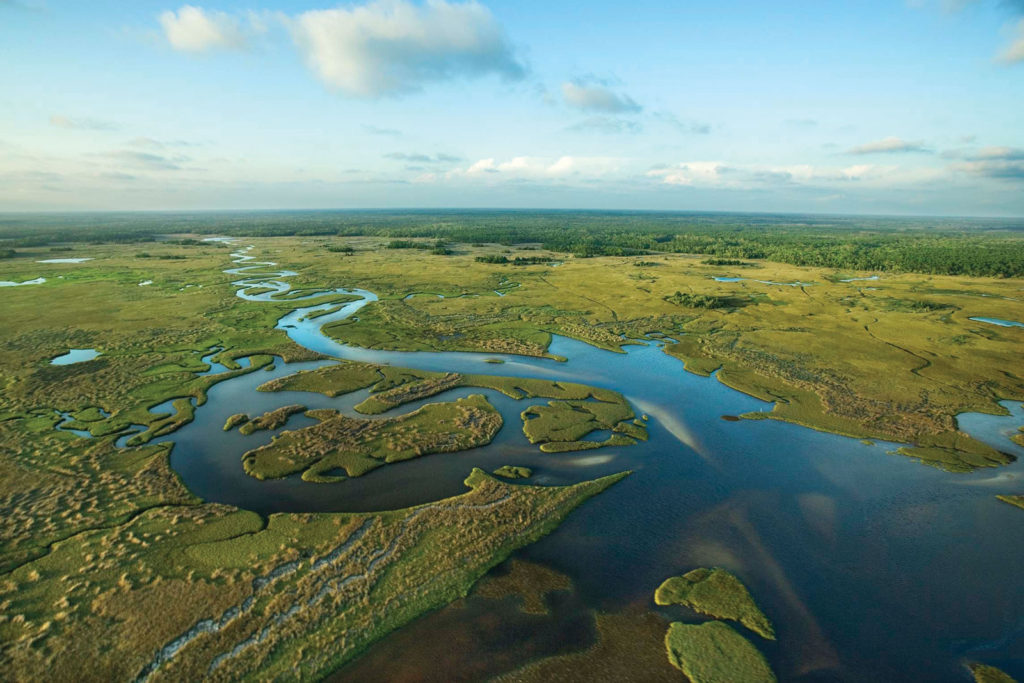
The Everglades National Park is vast and diverse with abundant wildlife. Photo courtesy of Brittanica.
Glacier National Park is one of the most amazing national parks to take your kids. The views alone will take everyone’s breath away and driving along the infamous Going To The Sun Road will never be forgotten. On top of that it is home to some of the best hikes we have ever done as a family. Our favorite trails in Glacier include hiking to unbelievable lakes such as Avalanche Lake and Hidden Lake and crystal clear, beautiful waterfalls such as St Mary Falls and Virginia Falls.
One bucketlist hike you have to do is the Grinnell Glacier trail. Add river rafting and animal sightings (we saw multiple bears and a moose) and you have the perfect outdoor adventure vacation for you and your family! There is never a shortage of things to do in Glacier.
Bryanna Royal is the founder of Crazy Family Adventure, where they blog about their full-time travels and outdoor adventures in a RV across North America.
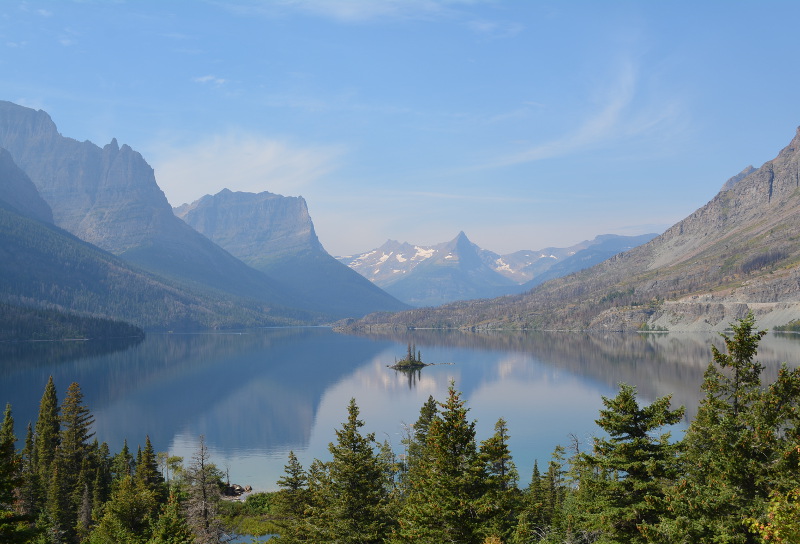
The iconic view of St. Mary’s Lake in Glacier National Park, Montana. Photo cred: Bryanna Royal
The Olympic National Park in Washington is one of the U.S.’s most diverse national parks. Only here can you visit a rain forest, glacier mountain peaks and beach all in the same day. When you visit, you can’t miss the famous Hoh Rainforest, the largest rain forest in the contiguous U.S. We loved walking the Hall the Mosses and the Hoh River trail. You will never see so much moss in your life!
Make sure to take a drive to the top of Hurricane Ridge where you can witness some stunning vistas of the surrounding mountain peaks, spot some deer, and take in a hike on one of the hiking trails in the area. The Sol Duc Valley is a stunning valley with waterfalls (such as Sol Duc Falls) and hot springs.
Probably the area of the Olympic National Park that we loved most was all the beaches along the west coast. Endless tide pools to explore and protected marine sanctuaries reside along this rugged coastline, and getting to them is half of the adventure! The hikes are short and beautiful to beaches such as Ruby Beach, First Beach and Second Beach. Also, if you’re up to a longer hike, the trail to Shi Shi Beach and the Point of the Arches will not disappoint!
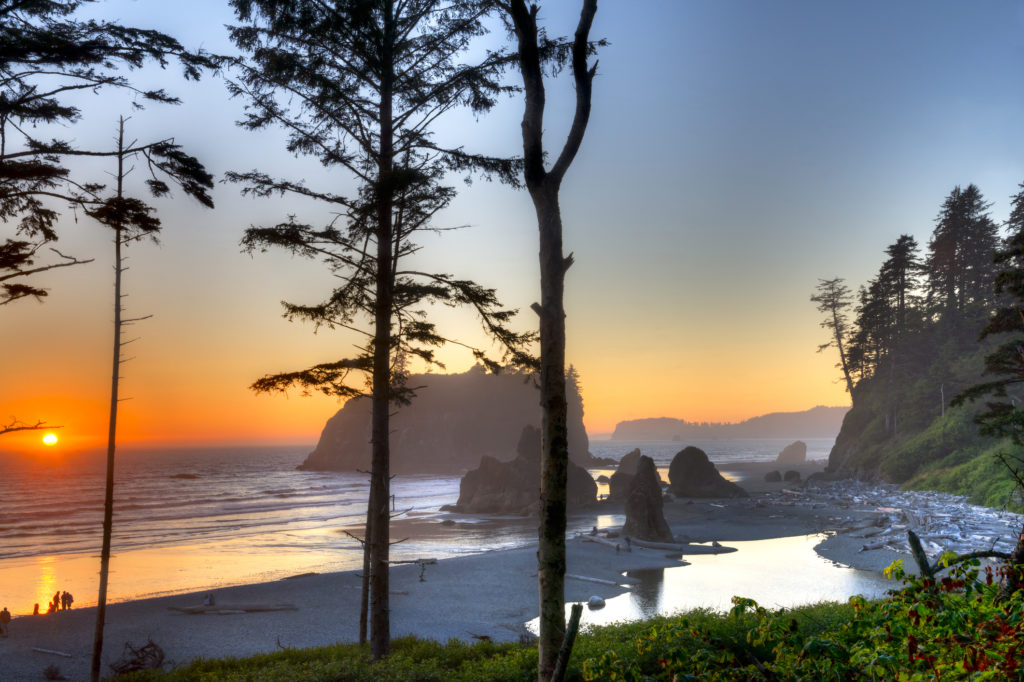
Sunset at Ruby Beach in the Olympic National Park, Washington
There’s something about being 6,700 feet up in the High Sierras of Sequoia National Park that lifts our family’s soul up, reminding us of just how grateful we are to have what we have and to do what we do, evolving and growing and mastering our awareness. Walking the land that John Muir fought so passionately to preserve so that future generations can breathe in the depth of its wild air is special and Muir’s voice resonates in our minds and propels us forward in our stewardship. “Climb the mountains and get their good tidings. Nature’s peace will flow into you as sunshine into trees. The wind will blow their own freshness into you, and the storms their energy, while cares will drop off like autumn leaves,” he said and we do.
In Sequoia National Park, you can’t miss exploring the groves of giant Sequoia trees, climbing Moro Rock, or visiting Crystal Cave which is a must with kids. If you are into hiking, there are lots of great hiking trails throughout the park and even in the backcountry.
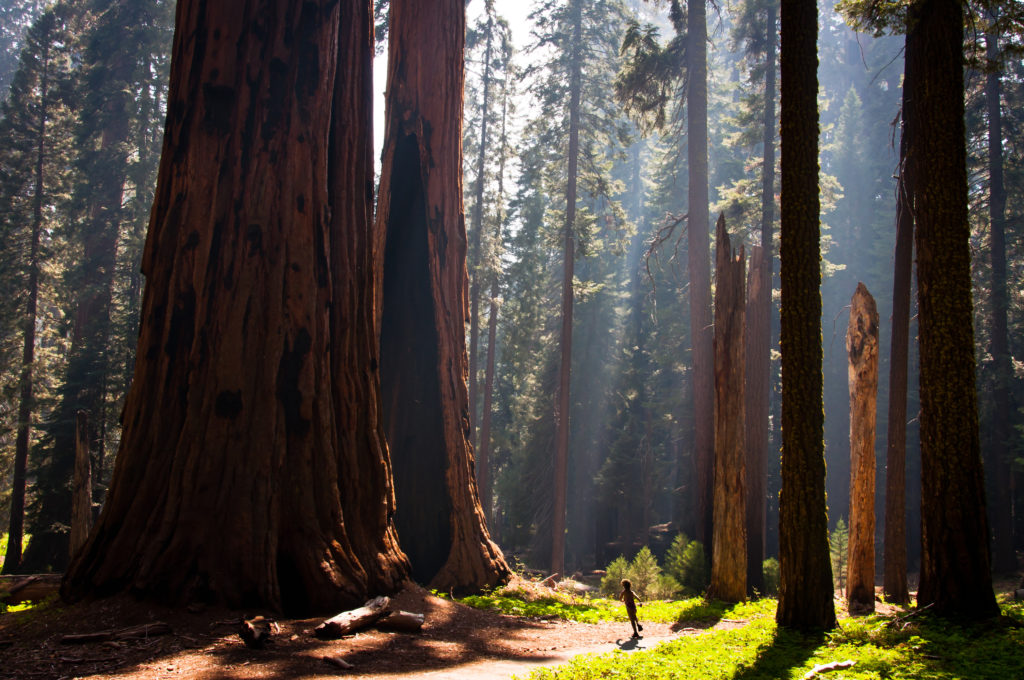
Sequoia National Park basking in its glory. Photo cred: Kerem Hanci
Jennifer Fontaine is a health, wellness, and family travel expert and founder and managing editor of Outdoor Families Magazine.
And that rounds up 25 of the best national parks to visit with kids. Is your favorite national park on this list? If not, what is your favorite national park and why?
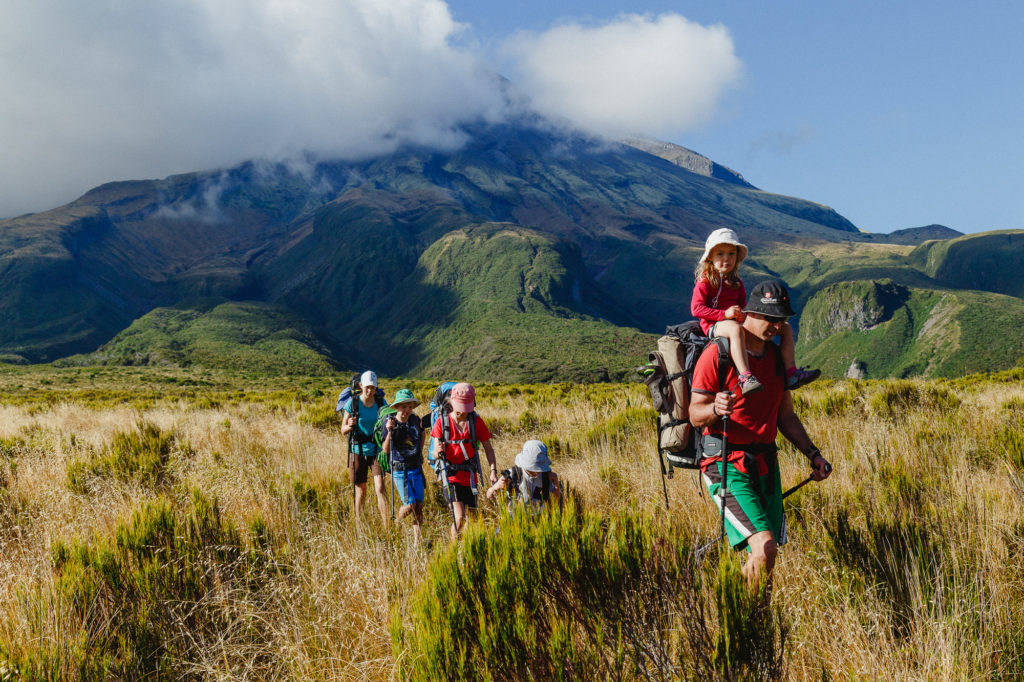
For a couple of small islands, New Zealand is jam-packed with such variety of terrain and outdoor activities. This makes it the perfect place to take kids! We’ve come up with a list of 10 family outdoor adventures you must do in New Zealand and the best part? Most of these are FREE.
There is no shortage of good beaches in New Zealand, that’s for sure. The west coast surf tends to be a little more wild, the east coast more mild. The Coromandel Peninsula has a lot of great beaches including Hot Water Beach where you can dig your very own hole at low tide, and it will fill up with hot water. Kids love doing this! Northland also has great beaches such as Paihia and Sullivan Beaches as does the East Coast of the North Island. The top of the South Island at Abel Tasman and Golden Bay also have excellent beaches. Grab a surf board, boogie board, skim board, go fishing, or just swim!
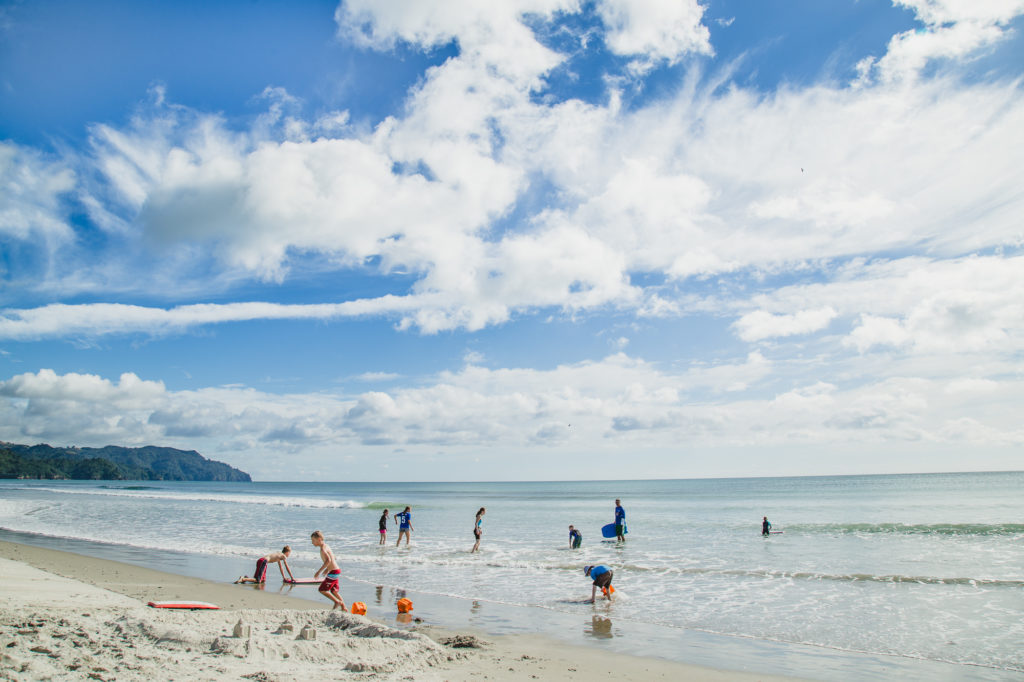
Waihi Beach
New Zealand has invested a ton of money into building excellent cycle trails for a variety of different skill levels, all over the country. Check out New Zealand Cycle Trail to get all kinds of ideas! We had a lot of fun on the Old Coach Road near Ohakune with our kids, plus it’s just beautiful!
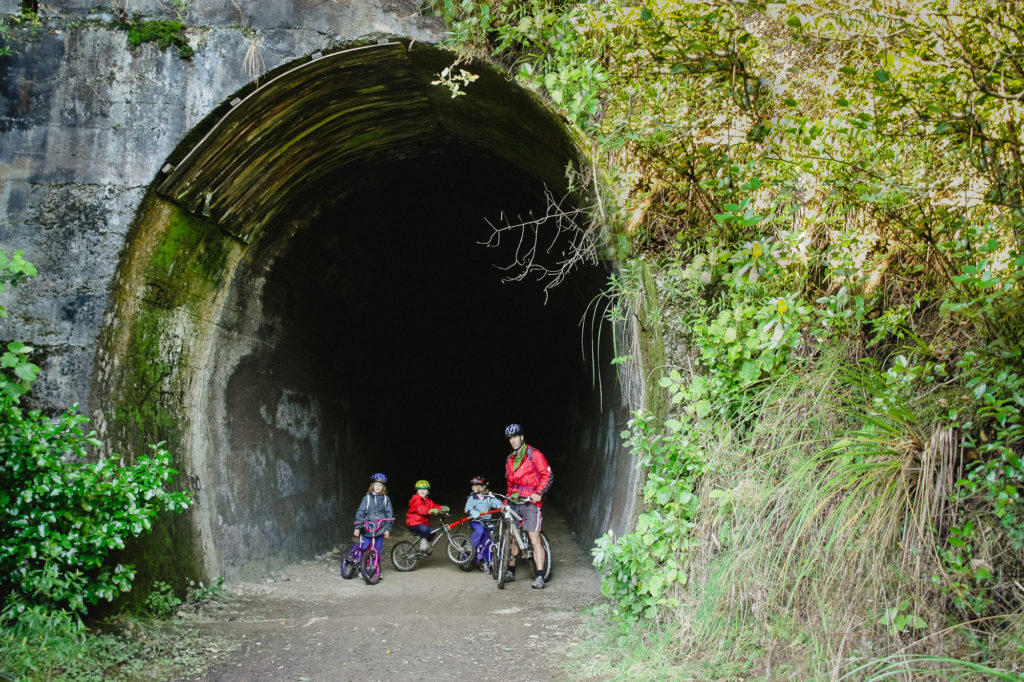
Cycling on Old Coach Road
Farming has been the backbone of New Zealand ever since it was first colonized. Since there are 30 million sheep to 4.6 million people in the country, it’s definitely worth learning about while you’re in New Zealand. Milk and Honey Cottage located on the North Island is the BEST. It is seriously one of my favorite places in the world. In addition to being a real working farm, it is set in the beautiful hill country. It’s peaceful, yet invigorating at the same time.
You can go on a farm tour, or a guided horse trek, wander down and check out the river or go on a hike on the farm. The kids love being able to see the farm animals up close too – chickens, working dogs, cats, horses, sheep, cattle. On our recent trip back to NZ, this was absolutely our kids highlight.
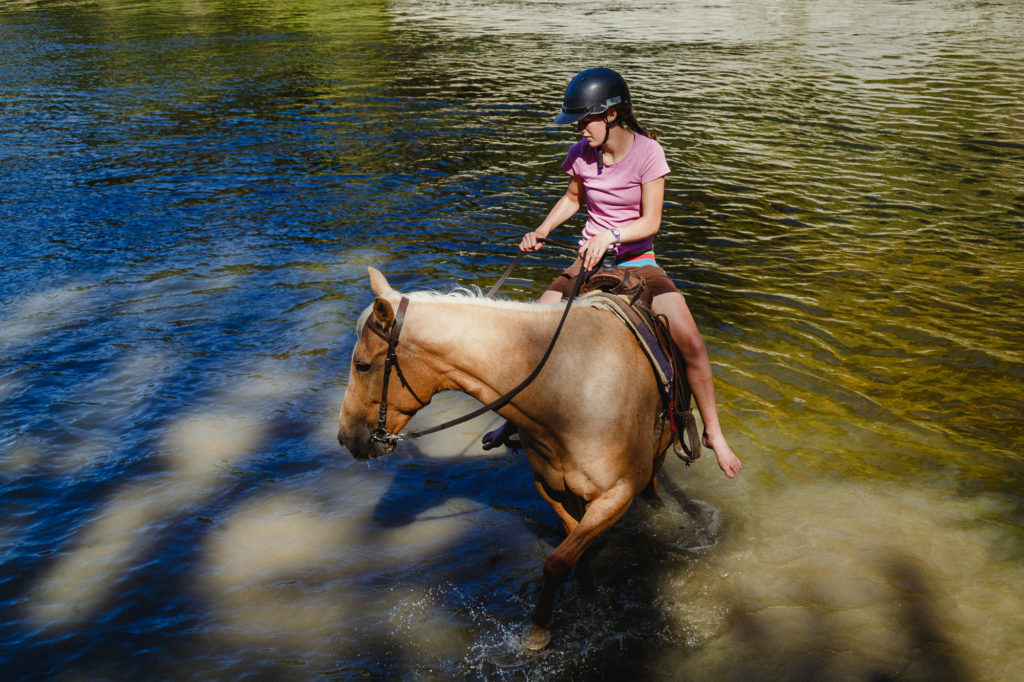
Riding horses on the farm at Milk and Honey Cottage
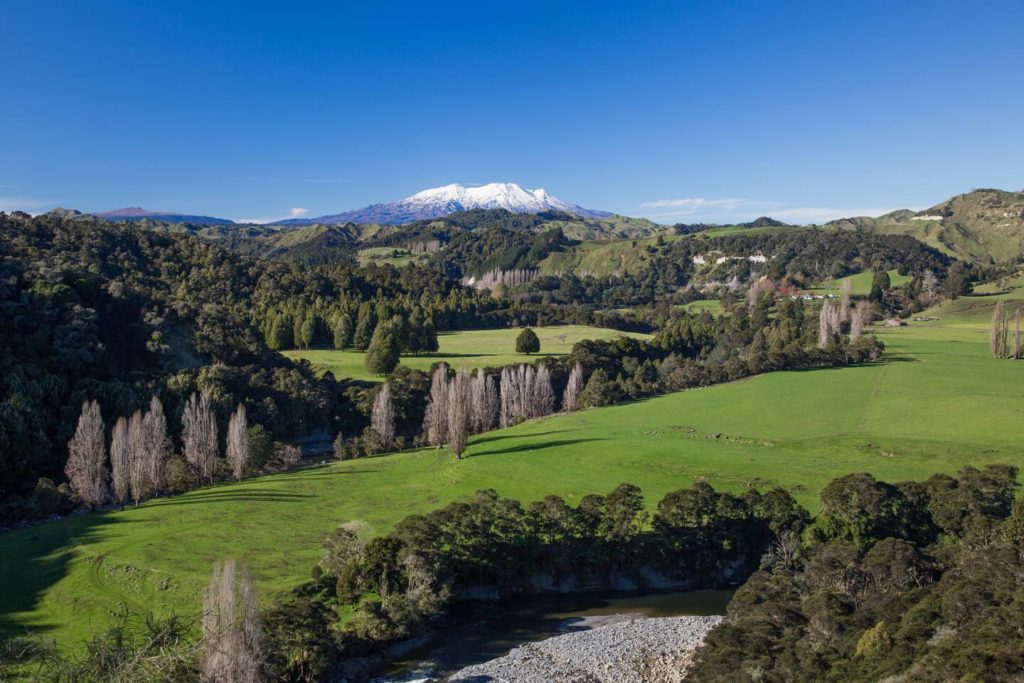
Photo courtesy of the Milk and Honey Cottage
These little worms typically live on the ceilings of caves, but are also all over New Zealand living in damp wet banks. They are about 1 cm long and the cool thing about them is when it is dark their rear ends light up blue. They look like the Milky Way when they are all lit up! There are many commercial caving tours that you can pay for in caves like Waitomo, but they tend to be expensive, especially for a family. Backpackers Guide New Zealand has a great list of caves that you can find glow worms for free and that are a little off-the-beaten-path though, such as Okupata Caves (for the adventurous) and the Kakahi, which we can personally vouch for.
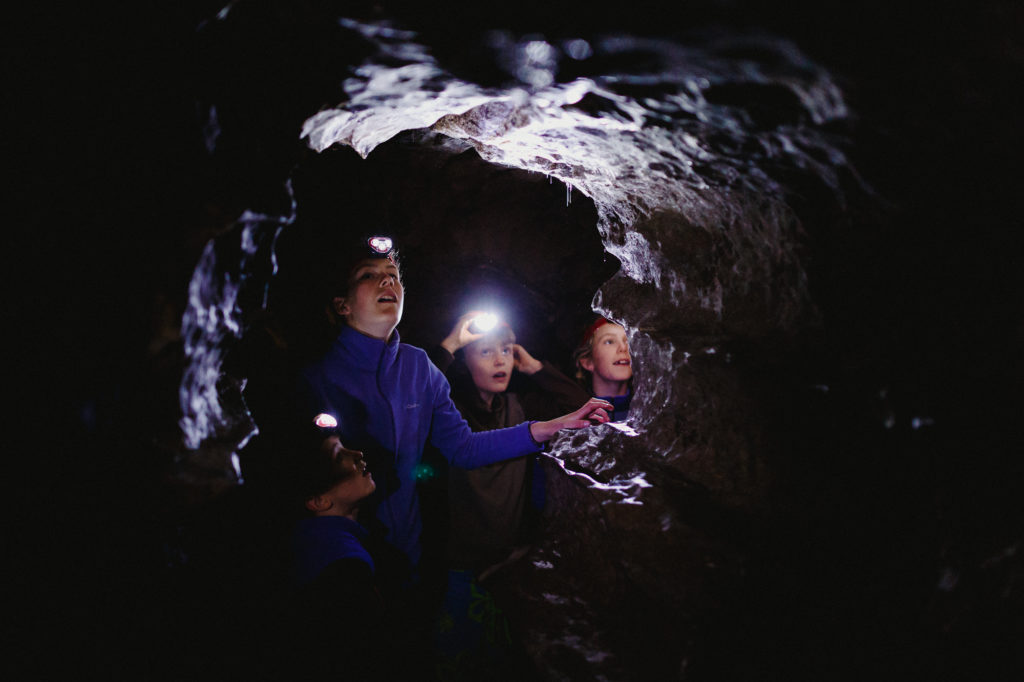
Looking for glow worms inside Okupata Caves
New Zealand has an amazing backcountry hut network. There are about 1,000 huts spread out over the country which can all be reserved with Parks & Recreation. There are a number of huts that are a short hike from the trail head that are perfect for families to backpack to. Remember, in New Zealand there are no snakes, bears, scorpions, or charging elk or moose, so it’s pretty safe. Just be prepared for mountain weather that can change at the blink of an eye.

Trekking across Pouakai to a backcountry hut
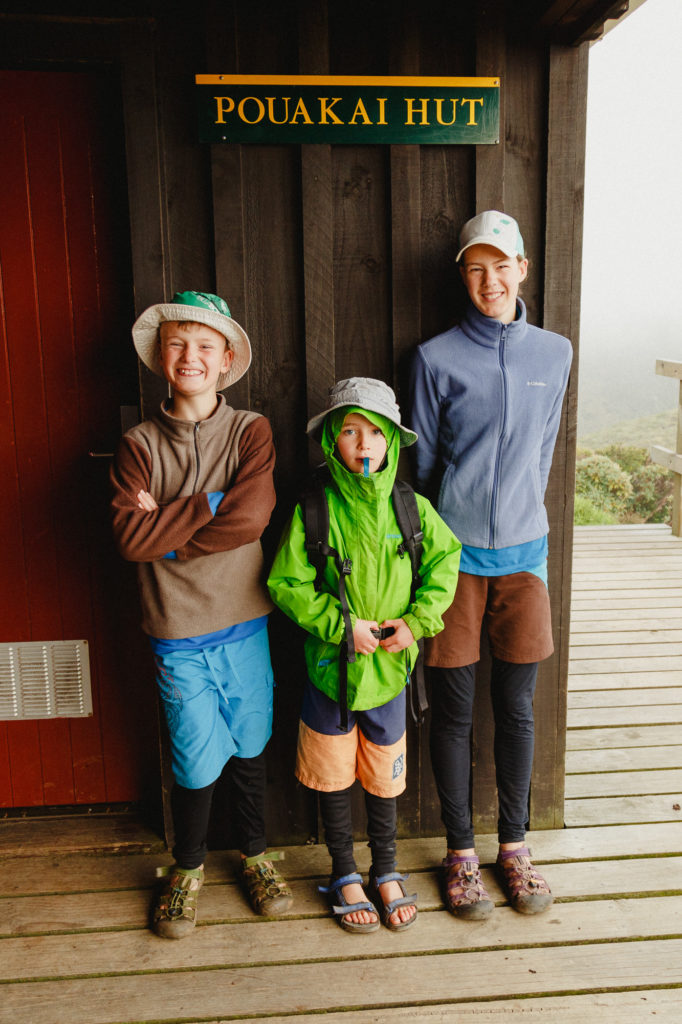
Thanks to the majority of the country sitting on the Pacific Rim of Fire, there is a fair amount of volcanic and thermal activity in New Zealand. Rotorua and Taupo are cities that are at the hub of some of this activity and both have free, natural places to soak. Try Kerosine Creek, Hot N Cold, Butchers Pool or Spa Park, all some of our favorites.
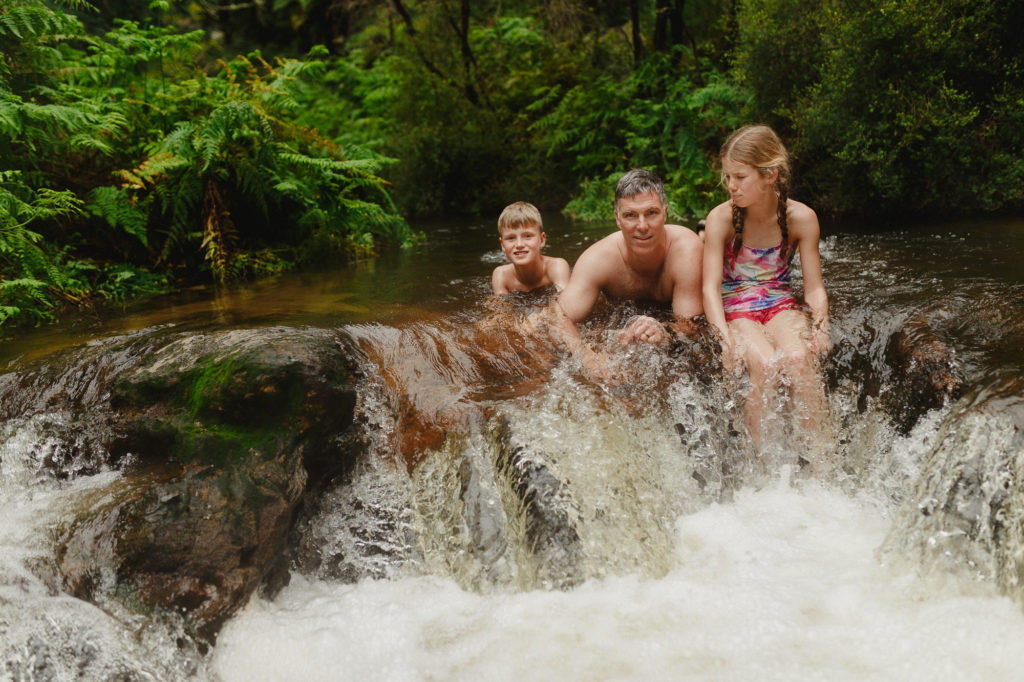
Soaking in the hot springs of Kerosine Creek
As soon as you land in New Zealand you will notice you can’t pronounce most names. The Maori indigenous culture is vibrant & unique here, and taking in a show in Rotorua such as Te Puia or Mitai is worth it.
The Franz Josef and Fox Glaciers on the West Coast of the South Island are unique because they terminate into temperate rain forest. You can hike a short distance to the terminal face, but if you want to spend the money, I recommend that you take a guided hike up onto the ice with a tour such as the Glacier Heli Hike.
Travelling from Christchurch to Greymouth through Arthur’s Pass allows you to get a feel for the topography of the Southern Alps of the South Island. It is beautiful and rugged landscape – just try and pick a sunny day if you can. And if you have time, explore Castle Hill, Cave Stream, and a short hike or two on the way. This will be a highlight of your time on the South Island. You also can’t miss Fjordland National Park, New Zealand’s largest national park which includes the famous Milford Sound.
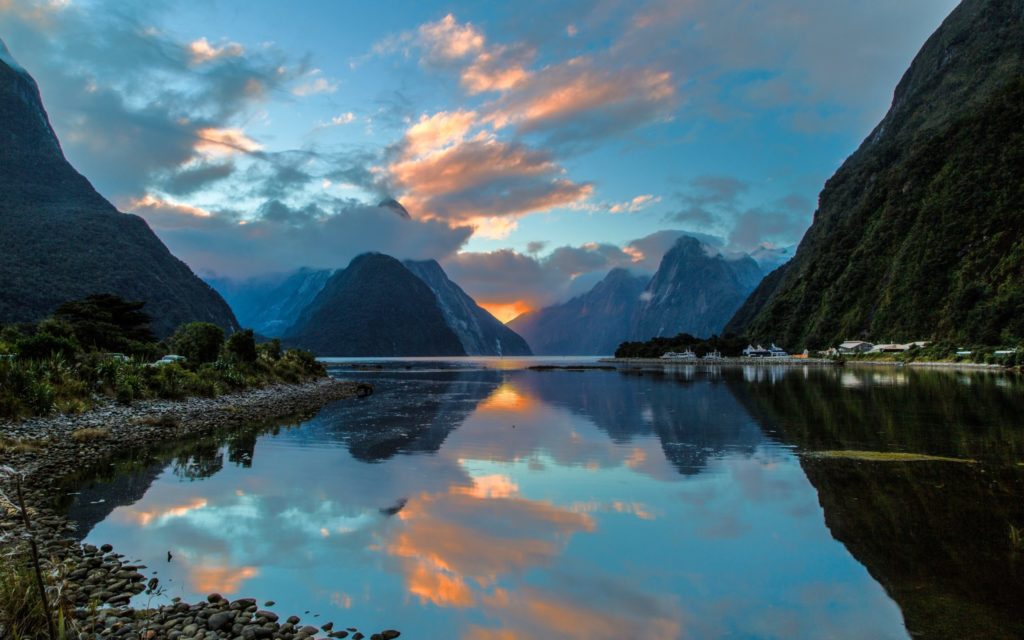
Milford Sound. Photo courtesy of Travel Diggs
Home to three active volcanoes, some epic landscapes and unique hiking opportunities is Tongariro National Park. You can also raft and ski in this park too. You might even recognize some scenes out of Lord of the Rings!!
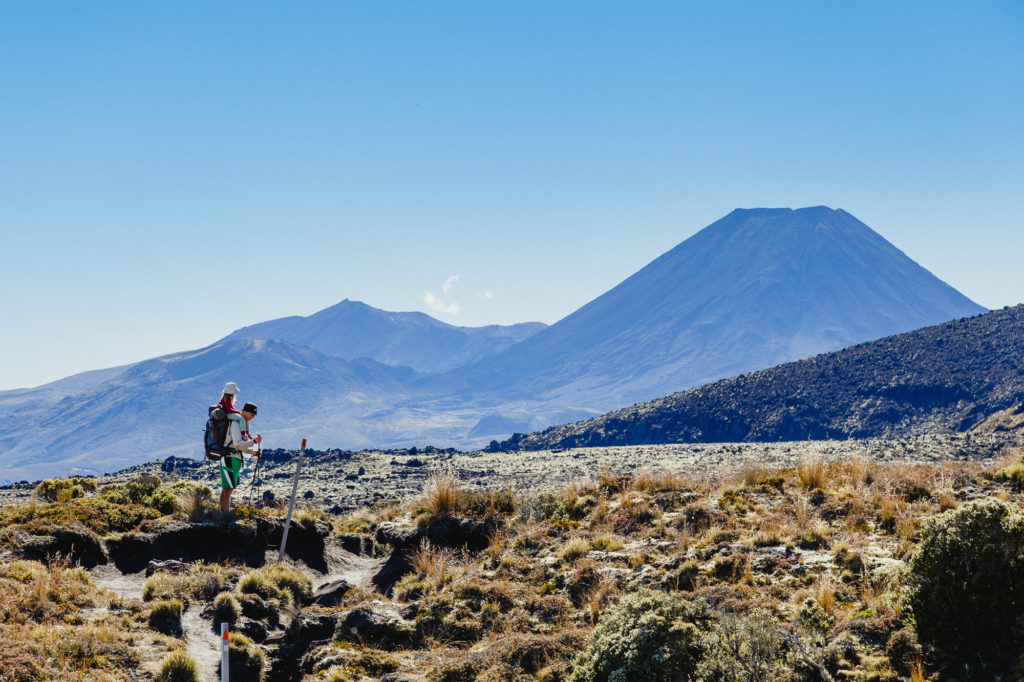
Hiking through Tongariro National Park
About the Nanninga family:
Leanne is the CEO (Chief Exploration Officer) for her hubby and 5 kids. Together as a family, they love to get into the backcountry where mountains and rivers are their favorite places to be. Currently residing in the Canadian Rockies, New Zealand used to be their home base. Follow their shenanigans on Instagram or on their outdoor adventure blog, Born to Adventure where they share tips on getting outdoors with kids.
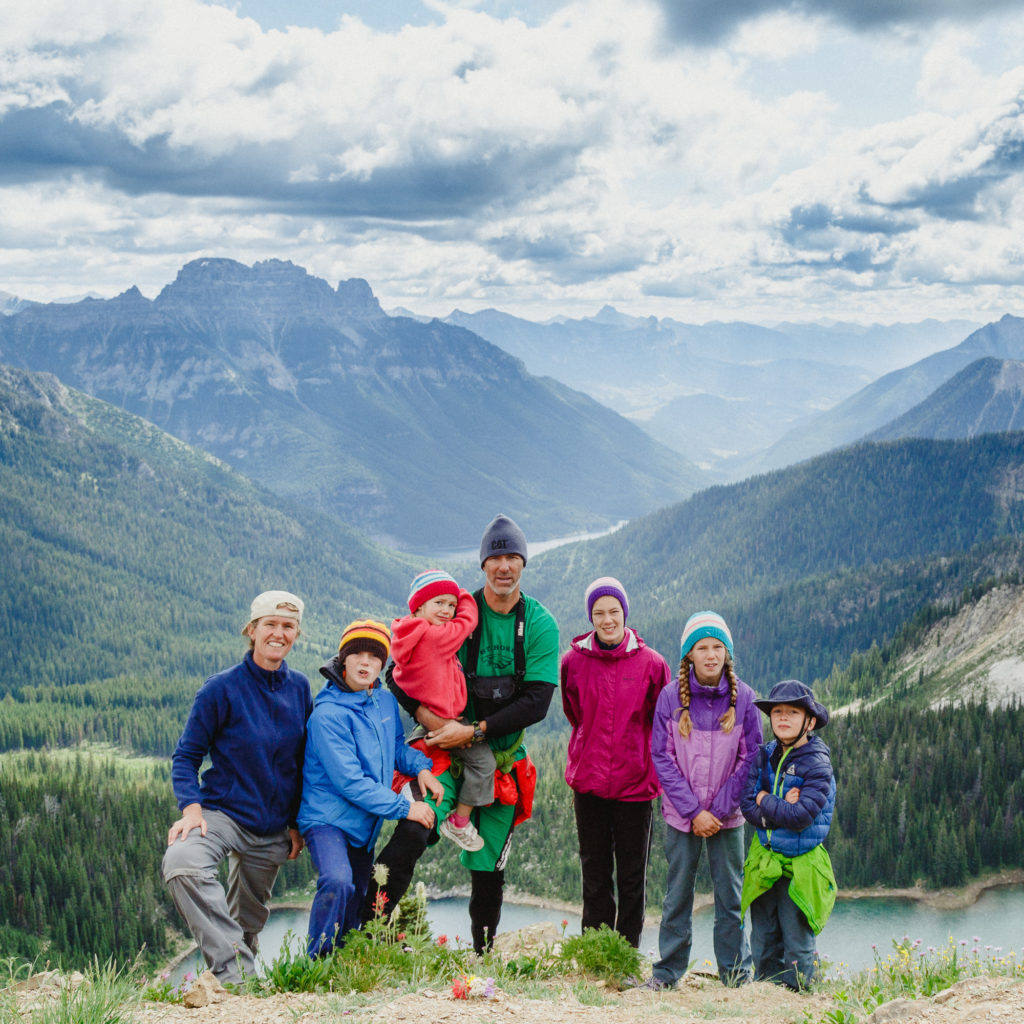
The Nanninga Family at home in the Canadian Rockies
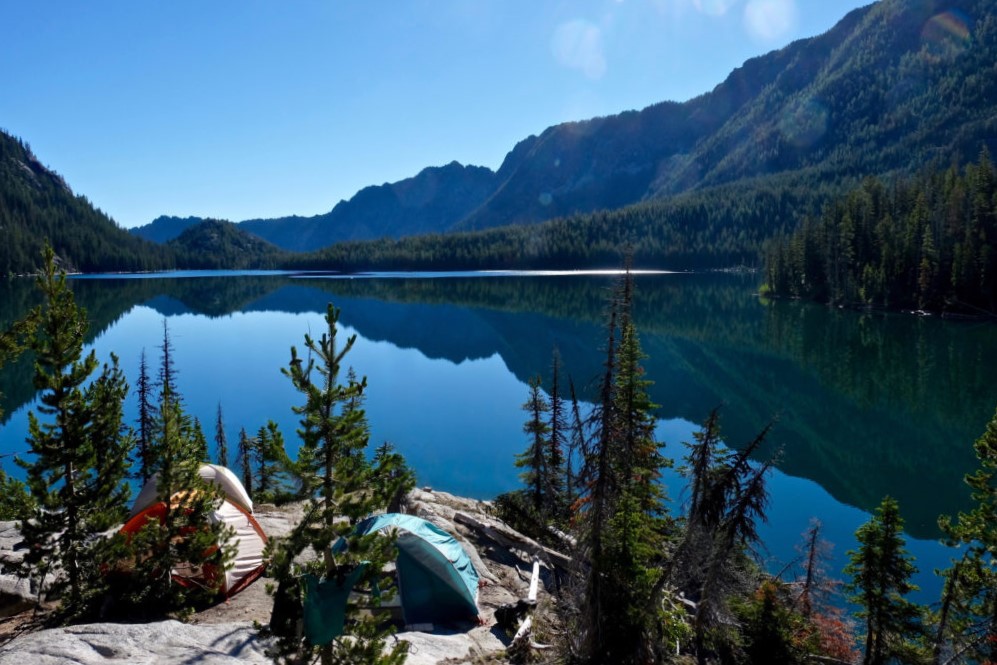
If you have ever camped with kids before (or even without kids) then you know how much planning and prep work it can take. Packing for a camping trip doesn’t have to be overwhelming or even time consuming. After years of experience of camping with kids, we have simplified the process (and the gear) and made a list of 20 steps to make camping with kids easy and fun. We have also included our top picks for camping gear that is inexpensive, durable, and compact.
*This post contains affiliate links, which means we receive a small compensation if you make a purchase clicking the links.
SO MUCH GEAR.
It can feel daunting getting all that gear ready for a camping trip, whether it is a weekend up in the mountains or a two week camping road trip, it doesn’t matter. They both require the same amount of gear.
You might asking yourself, “Why on Earth would I go camping with kids then?”
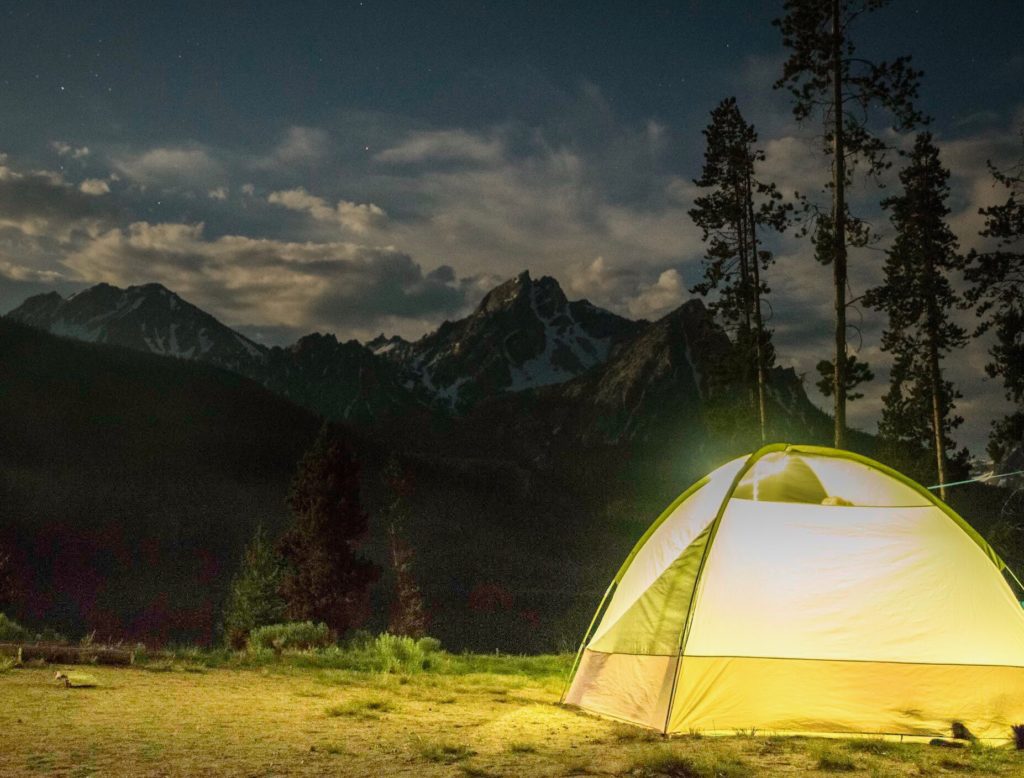
Nothing better than sleeping under the stars!
Because camping as a family is fun. A LOT OF FUN. Some of our most favorite memories together are from camping trips. It’s just us and the great outdoors–no cities, no traffic, no TV or media, no toys, no distractions. And then there is that fresh mountain air. Ahhhhh. And the campfires. Oh, the campfires! Sitting huddled around a campfire, swapping stories, laughing, and roasting marshmallows by the fire are absolutely priceless memories. But our favorite part? Sleeping under the stars, with only the sounds of nature (next to a river is our favorite) to fall asleep and wake up to.
To make it easy, we have figured out a few shortcuts to making all that packing/prep work before a camping trip much easier. The key is to be a little organized and to plan ahead. Here are our tips to include preparation, packing and gear, food (including our go-to, no fail camping meals!), easy DIY ideas and lastly, some fun games and entertainment ideas to do while you’re camping.
Because most campgrounds fill up fast, you will need to plan ahead to secure a campsite. A little bit of research can save you the time and stress of showing up without a reservation and then not being able to find a campsite (trust me, we’ve done that!!). Of course, depending on the area you are going, you might not need to secure a campsite ahead of time. If you are more of a back-country camper, then you will want to find out the permit process for that particular trip.
With that being said, we generally like to camp somewhere near a body of water (lake, river) and also have access to a bathroom (if possible), so when we are choosing a campsite online, we make sure to look at the campground map (pictures are always best) and see where we are in proximity to those things. We also prefer trees and shade, and a decent amount of space between campsites, so we try to pick a campsite that hits all of our requirements if possible.
Camping with friends is always more fun for everyone. Just make sure if you are going with friends, that you get enough campsites to fit everyone. (Most campgrounds have restrictions about how many tents/campers are allowed at each campsite.)
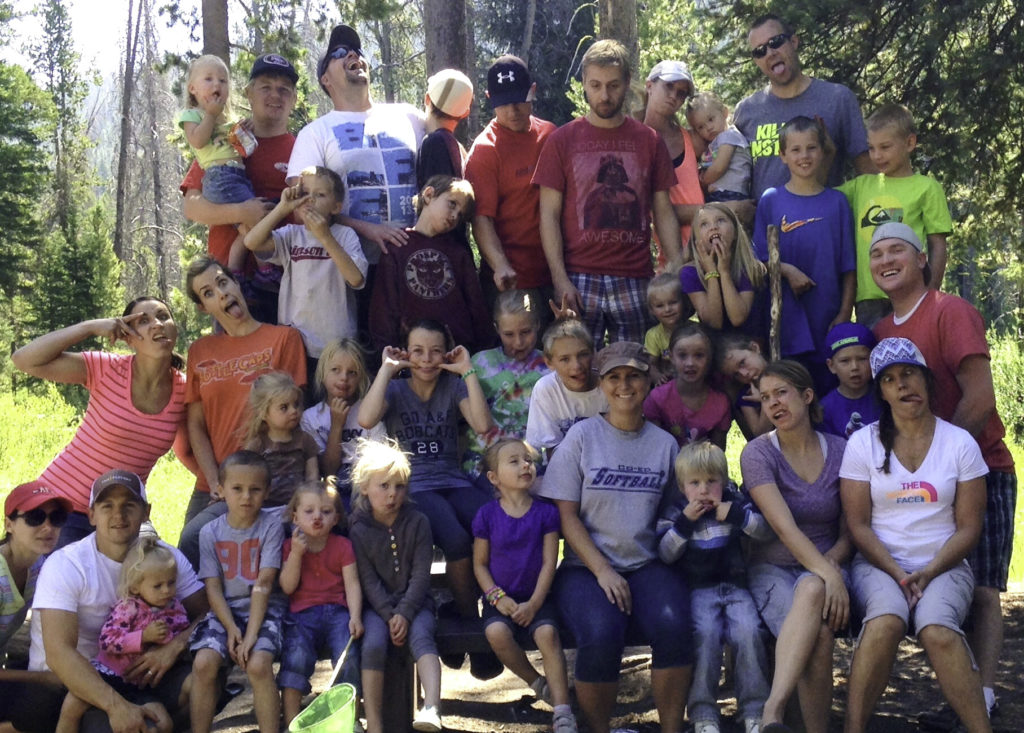
Camping with friends can be crazy fun!
Get your camping list out a couple weeks before and start gathering and organizing your gear, so you aren’t doing it all the night before. This is a good time to check your stock of certain items (for example: TP, matches, propane, etc) and make sure to pick up those items when you’re at the store.
Planning meals and getting a list of food items ahead of time saves you a lot of headache in the long run. Write down what you plan to eat for each meal (breakfast, lunch, snacks and dinner. And don’t forget dessert!) and then prepare what you can at home—marinate the meats, cut the vegetables, wrap the potatoes in foil. You’ll be thankful once you get to camp. More on this under Food for a camping trip.
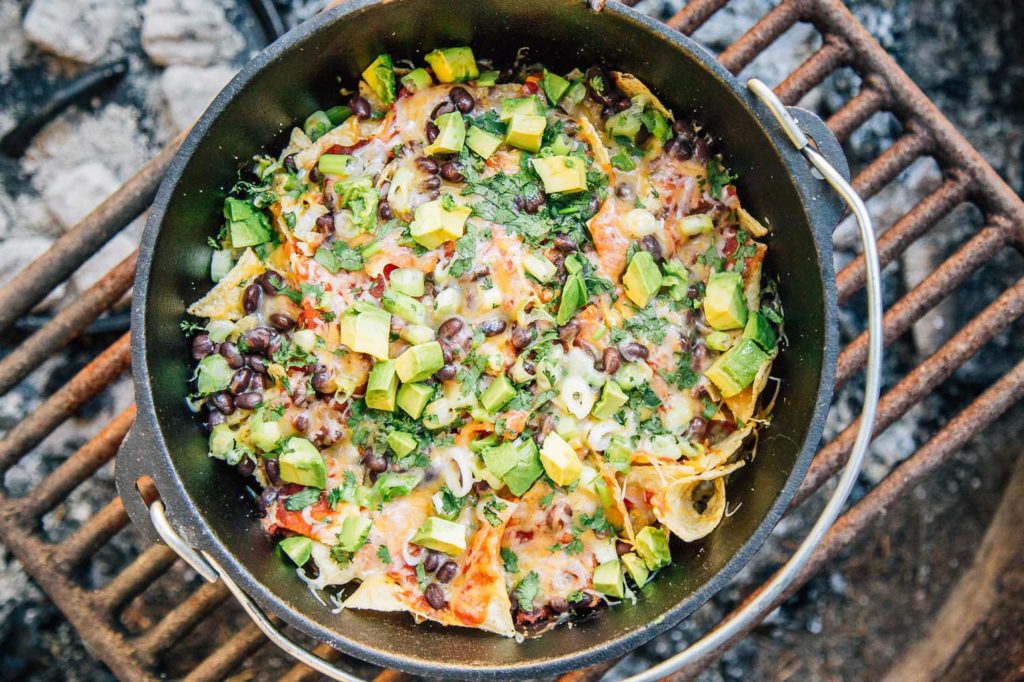
Campfire nachos. Photo courtesy of Fresh Off the Grid.
Kids love camping and being involved in the planning process, so use those minions and delegate some responsibilities. Have the kids gather camping gear, check batteries, re-stock TP, etc. Also, involve them in planning activities, and setting up and taking down camp. Lots of hands make for a light load.
This tip alone has saved me so much time in packing. Basically, we have a few storage bins we keep in the garage that have ALL of our camping gear in. One bin occupies sleeping bags, pillows and mats, one has tents and tarps, and a couple other bins have all the rest of our camping gear. Instead of having to find and retrieve utensils and kitchen items from the kitchen, everything is all in one bin. These industrial wheeled storage bins are our favorite because they pack a lot of stuff, plus they can withstand weight and can be stacked on.
When you pack the cooler(s), set out the foods meal by meal, thinking about how you’ll serve each meal, so you don’t forget condiments. Use a couple of frozen gallons of water to keep everything cold (and to use as drinking water) at the bottom of the coolers (or a block of ice, not ice cubes since those melt faster). Make sure to put items like pre-made camping meals, meat, cheese, milk, etc on the bottom too where it will stay coldest. Condiments next, and then produce on top. We usually bring two coolers like this Coleman wheeled cooler for longer camping trips (not including a 5 gallon water jug), and we designate one for dinner meals and one for breakfast and and lunch foods.
What kind of tent do you need? If you have a large family, you will want something that will fit all of you comfortably, and maybe even a tent that has two separate compartments (great for separating kids from parents!). Be aware though that some larger tents can often take longer to put up and take down. This Coleman Sundome tent sleeps 6 comfortably and is super easy to set up. We are big fans of pretty much anything Big Agnes makes, so this Big Agnes Copper Spur tent (sleeps 4) is awesome too, especially if you like to stargaze while laying in your sleeping bag, as it boasts big windows on all four sides and is lighter weight.
Tip on back-country camping with kids: for a lighter load, bring two backpacking tents (for 2 or 3 persons) and have the adults pack them instead of hauling one larger tent. Trust us, your back and shoulders will thank you.
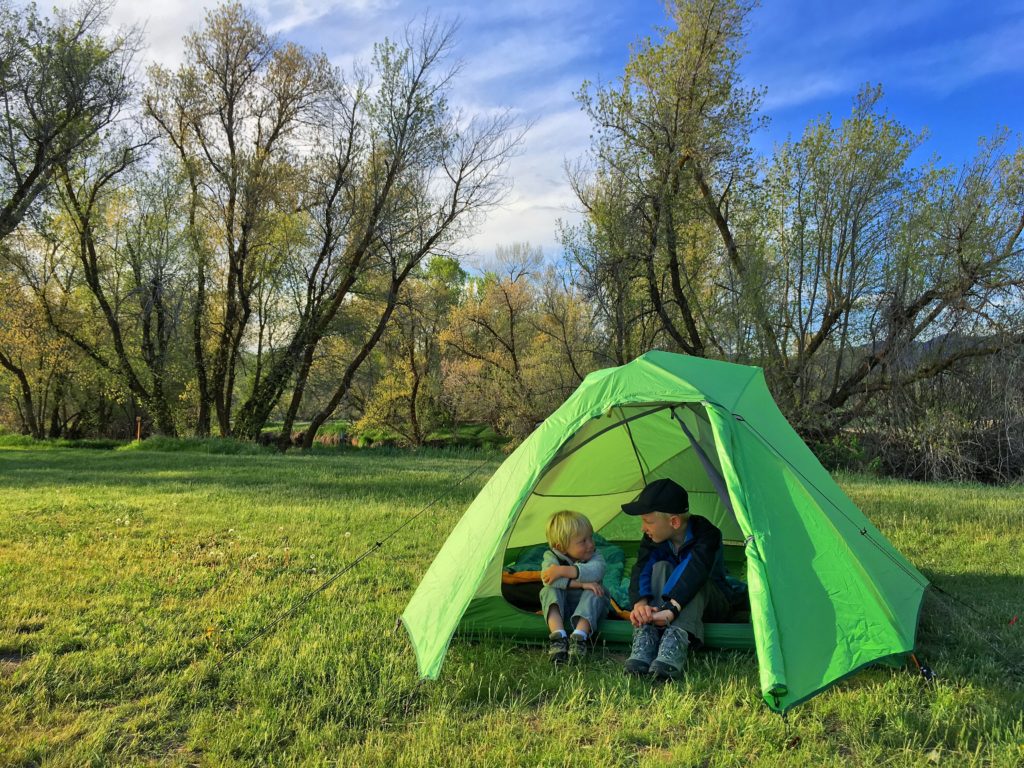
Some other things to consider when choosing a tent: choose something that will fit well on most campsites. Having a double door is nice too. Also, we like having a tent with a large fly, creating a vestibule or entry way where we can store gear, shoes, etc. Less gear in the tent means more movement inside (and hopefully less dirt too)!
After selecting the right shelter, finding the best sleep system is the next most important step in having the right gear to make your camping experience easy, enjoyable and COMFORTABLE. We love this Teton Sports Tracker sleeping bag because it keeps you warm down to 5 degrees Fahrenheit and its a great price point. This double sleeping bag is great if you have small children and want them to sleep with you (or you want to cozy up with your spouse). The Kelty Big Dipper kids sleeping bag is one of our faves for kids because it is warm enough for temperatures down to 30 degrees.
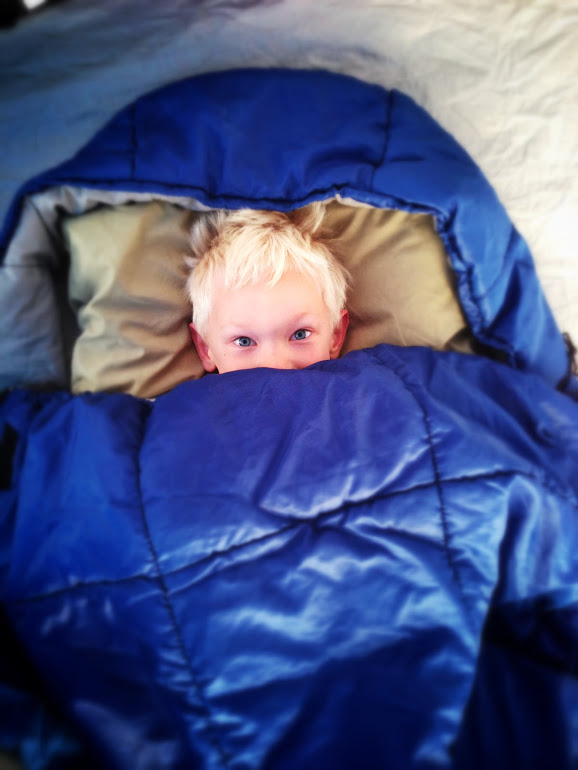
Having the right mat or mattress is crucial too and can make or break your camping sleeping experience. We absolutely love these Big Agnes Air Core sleeping pads because they blow up nicely (almost like an inflatable raft), are insulated, and pack light and compact (great for backpacking too!). For some people, air mattresses are the way to go, because it’s like bringing your bed to your tent. This elevated plush air mattress with an electric pump and this reasonably priced air mattress with ComfortCoil technology can sleep two adults or 3 children comfortably.
And then there are cots, which are great if you want above the ground camping. This Coleman Trailhead sleeping cot is one we’ve had our eyes on and gets great reviews. Lastly, hammock sleeping can be nice if you have the right hammock, a good top blanket, and an insulating pad or mattress. We suggest the ENO Double Nest hammock and ENO hammock mattress, which is also insulating.
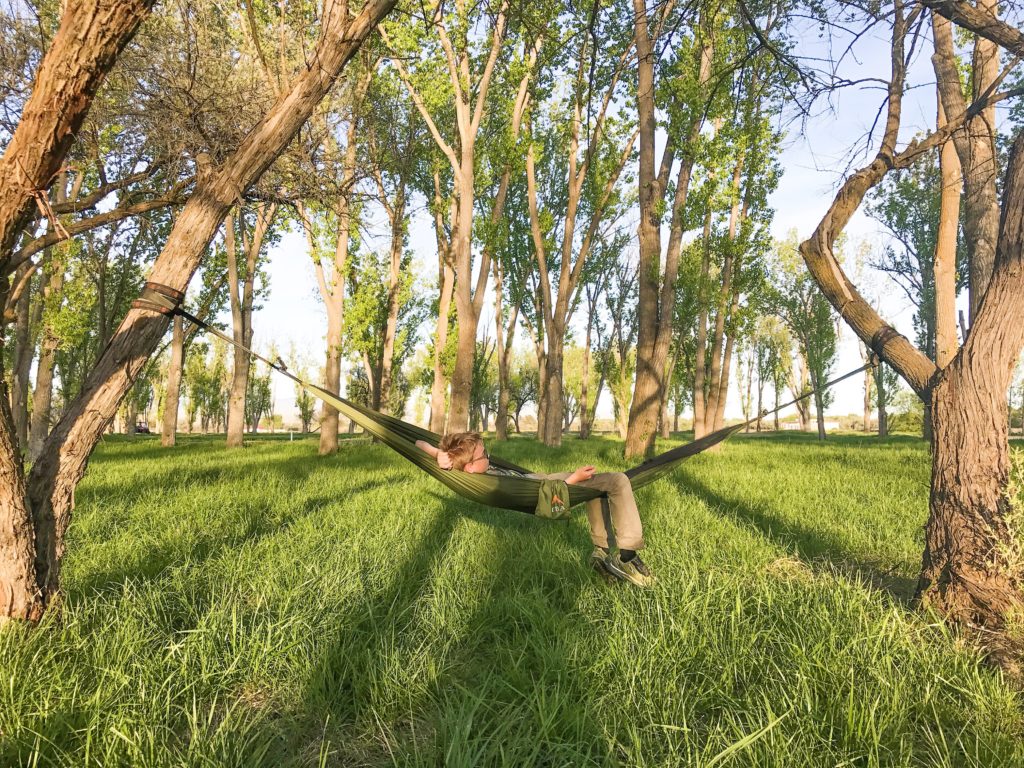
We usually prefer situating our tent between trees in the shade (especially in summer), plus if it rains, you can tie up a rain canopy like this Kelty tarp shelter (in addition to your tent fly) to cover your tent and surrounding area. Another great tip is to place a large tarp or old rug under your tent so you have space for putting shoes.
We also love putting up some tent rope lights like this Loominoodle light rope and lantern because they give the tent some nice ambient light and are powered by a battery. And lastly, at the end of your camping trip, do a quick audit of the campground and take notes about what you liked and didn’t like about your campsite, which campsites in the campground to avoid, which campsites might be better, etc. This info will become useful if you revisit this campground again.
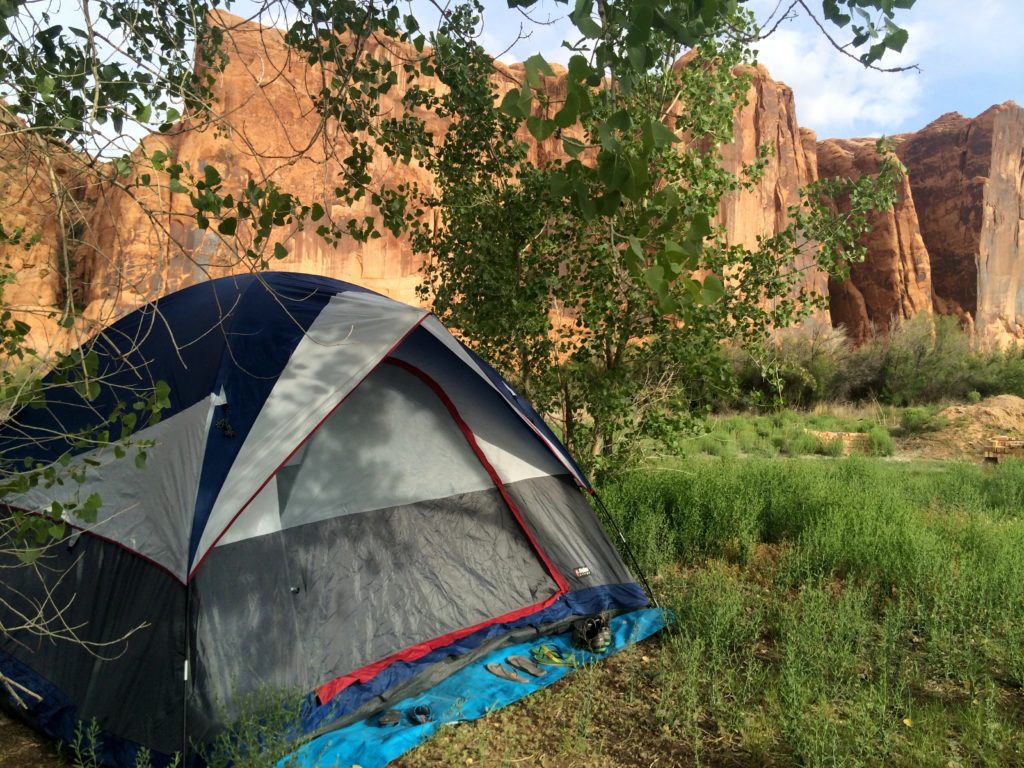
Camping along the river in Moab was the perfect spot to set up camp.
You might adapt this list to your needs, but this is our comprehensive packing list to include anything you might need while camping. (Remember, most of these items we keep in bins, so the only real packing we have to do is clothing and food.) Also, if you are going with friends, you can split the list (for certain items) as to lighten your load.
To see where to find the best, most affordable camping gear go to Must-Have camping gear or check out our camping gear page for a comprehensive guide of our top camping gear picks.
Camping food doesn’t have to be boring. In fact, some of our favorite meals are the ones we make camping! Utilize shelf stable food options when you can to save on valuable cooler space. Modify recipes to only only use one pot (no one enjoys clean up duty). Also, consider cooking meals that use common ingredients so that you can minimize the number of ingredients that you have to bring. For example, last night’s leftover chili can go on top of your baked potatoes. Know how long each meal needs to cook and plan accordingly. Find some great camping meal recipes online, such as Six Sisters Stuff, or Campfire Recipes, which are recipes adapted and made for campfires. Here are some of our Camping Recipes.
We love doing desserts in the Dutch oven too, such as our favorite Dutch Oven Chocolate-Cherry Cobbler, or Paula Deen’s Dutch Oven Peach Cobbler, and the always classic Dutch Oven Apple Crisp. And of course, there are always s’mores! For our s’mores, we like to get fancy and use different kinds of chocolate such as Ghirardelli, Reese’s Peanut Butter Cups, York Peppermint Patties, and Cadbury Milk Chocolate and Caramel.
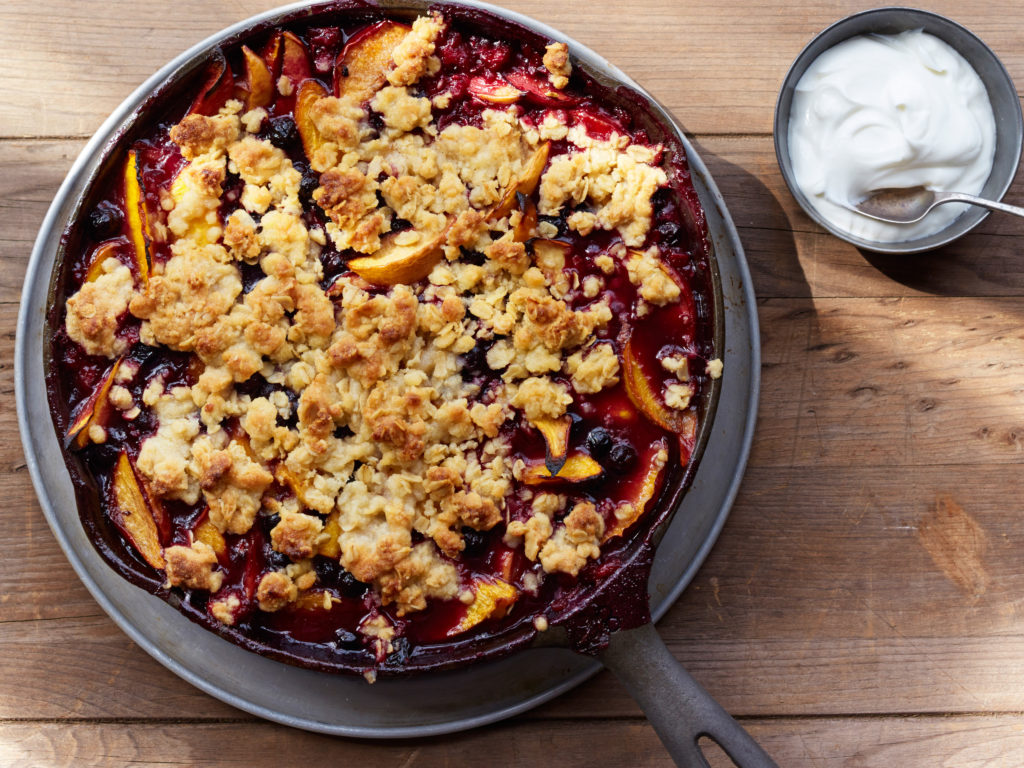
Dutch oven peach berry cobbler. Photo courtesy of Dish Maps.
This tip always saves my bacon. Because let’s be honest, the last thing we want to do when we’ve been out all day hiking, or playing at the lake is come back to camp and have to make a big meal. The week before a camping trip (even a weekend camping trip), we try to do the food prep at home. For example, for dinners, we will pre-make the tinfoil dinners ahead of time and freeze them. Same with the chili (freeze), chicken or tuna salad for sandwiches, etc.
It’s a good idea to start your fire on one side of the fire pit, and add wood on the other side. This creates the perfect spot for coals to cook on (away from the fire). Once the coals are ready, you can place the dutch oven on the coals (with additional coals on top of the dutch oven).
Practice and teach fire safety. Some of our go-to, easy fire starters are cotton balls with a bit of petroleum jelly smeared on it (store in ziploc bag), or toilet paper rolls filled with dryer lint or vacuum lint. When you get to camp and have set up your shelter, enlist the kids to go find and gather wood of different sizes (kindling/tinder, small sticks, and bigger logs) and have them separate them into piles of their respective sizes. It’s always smart to take multiple fire starting methods with you on every camping trip since some might work better than others in different weather conditions.
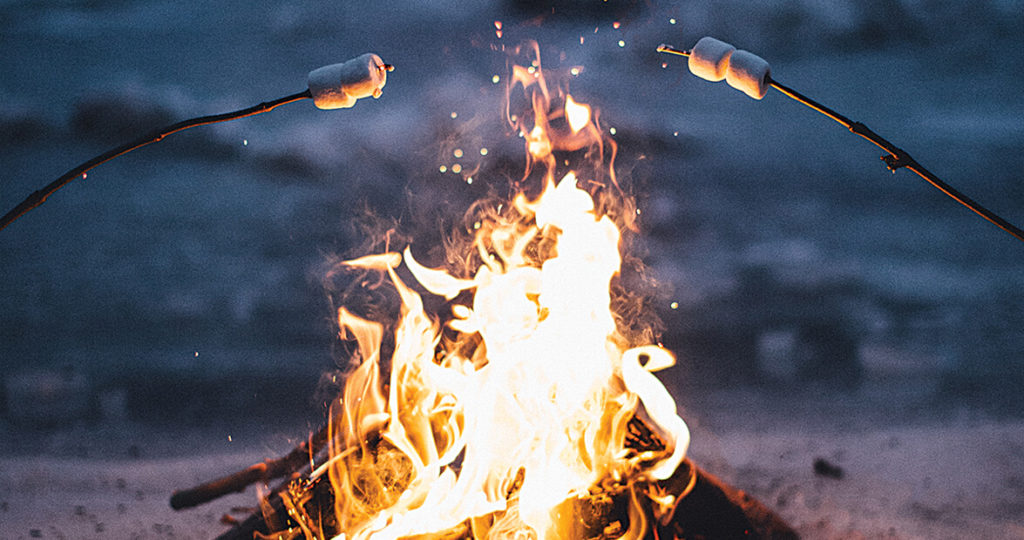
Since fire pits get hot quickly, use some rocks to surround the fire pit, creating some distance between the fire and the kids. Make sure to explain not only the dangers of getting close to the fire with your kids, but also how to start a fire so they know how it works. Most kids will want to “poke” the fire with a stick, so it’s a good idea to establish a rule where only one person can poke the fire (and that person should be an older, responsible child or an adult).
For one night, about 12 logs (split into sections) will provide enough wood for cooking dinner and for fueling a comfortable fire late into the night. Always have extra wood on hand, for emergencies (such as a wet, cold day), or an unplanned bonus day. Dry, light wood will burn faster than hardwoods so take that into consideration. Camping in colder, alpine climates will burn up wood longer than camping in a warmer climate. Make sure to keep count of your logs and how many use, so you know how long your stack will last you.
Having a clean campsite is important for keeping the “clutter” to a minimum (easier said than done with kids), but also important for keeping the critters away. Also, when you are sleeping or gone during the day, make sure your food is stored away in food lockers (most campgrounds have these) or your car (with windows rolled up). Garbage should be hung high on a tree, tucked away in a locker, or thrown in the dumpster. Do not store food in your tent, repeat, do not store food in your tent!
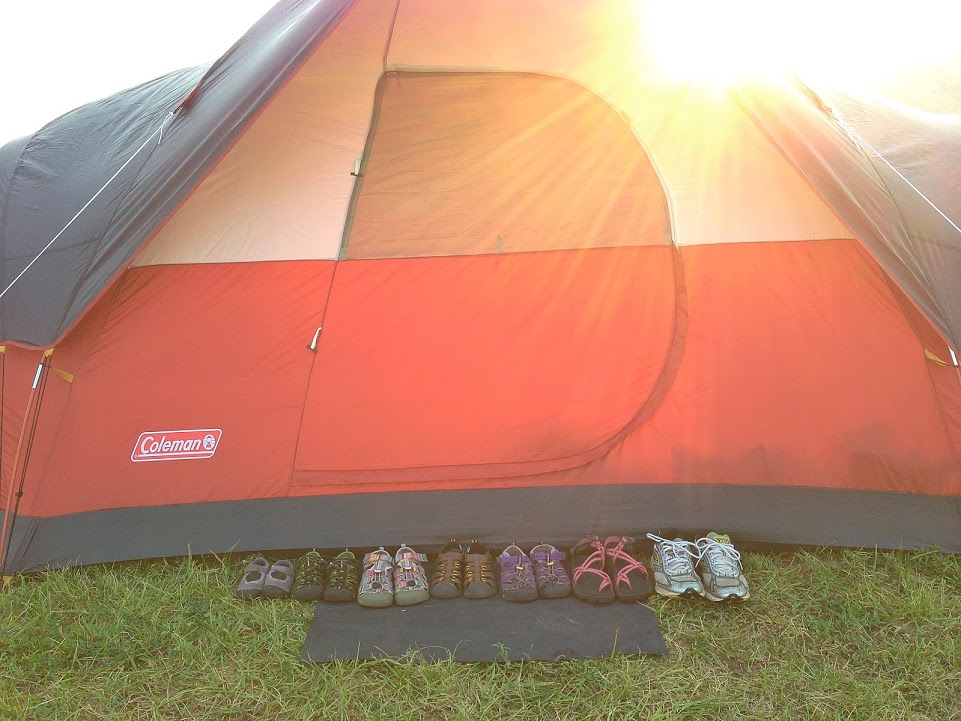
We are all about making the clean-up easy while we camp. Use a designated storage bin or a cheap wash bin for all your plates, pots, utensils, etc that need to be washed each day. And then when it comes time for clean-up duty, have the kids help! Make it a game with a prize (such as an extra s’more). Also, give the kids the task of finding any debris or garbage at the campsite that doesn’t belong.
You don’t have to have the fanciest camping gear to have a great camping experience. For example, you can create an easy, cheap portable hand-washing station with just a 5 gallon jug of water (with spigot), a bucket, a roll of paper towels (with a holder), foaming soap and bungee cords.
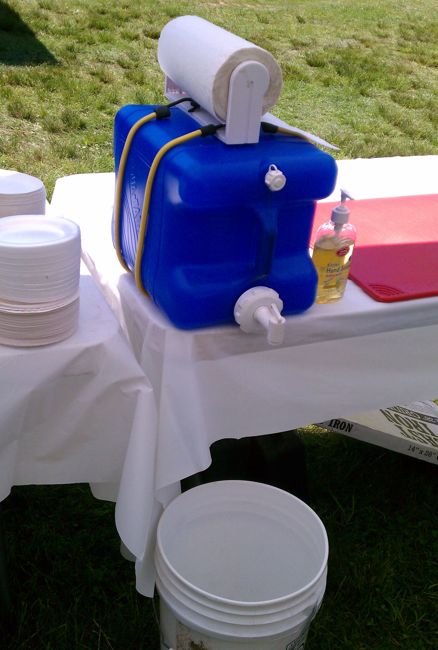
Easy DIY hand washing station. Photo courtesy of Pinterest.
Inside your tent, you can use those foam floor tiles on the ground under your mats and sleeping bags, for a more comfortable ground (especially for toddlers to crawl on).
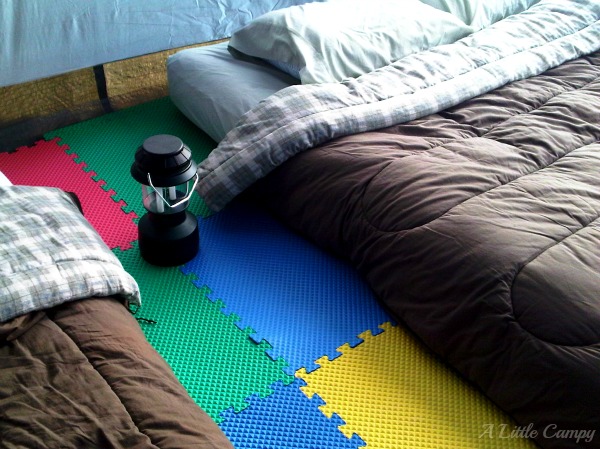
Foam floor tiles. Photo courtesy of A Little Campy.
For an awesome makeshift lantern, all you need is a 1 gallon jug of water and a headlight!
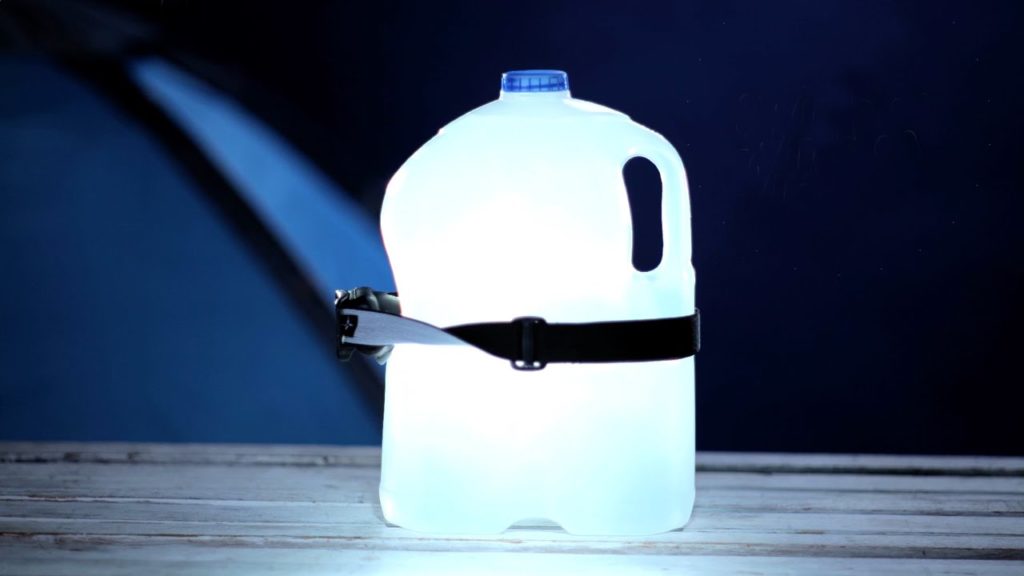
DIY camping lantern. Photo courtesy of Pinterest.
Check out some more awesome DIY ideas for camping.
Normally, we keep the non-essentials to a minimum since we are big believers in letting the kids use nature as their playground when we camp (sticks, rocks, etc). However, with that being said, occasionally we love bringing a few “extras” on our camping trips.
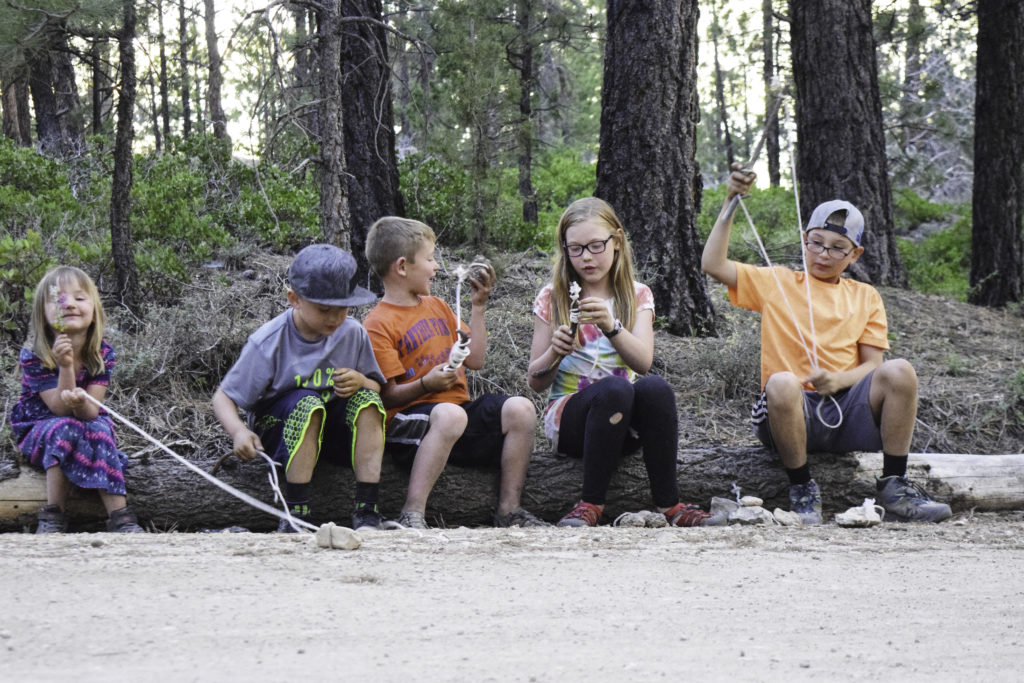
Going “rock” fishing
Slackline: This is a crowd favorite (for kids and adults!) and it’s easy to set up. All you need is two trees at least 30 feet apart. Slacklining is becoming one of our favorite outdoor pastimes because it is so fun and addictive! We love a good challenge too, and the slackline delivers! When you are learning, it’s a good idea to tie up the slackline fairly low to the ground, so when you fall off, you don’t go far. But also make sure to get a slackline that has a training line. The training line helps you keep your balance as you are learning to slackline and as you progress, you don’t need the training line anymore. We also suggest slacklining barefoot and starting out in the center of the slackline first (opposed to the end).
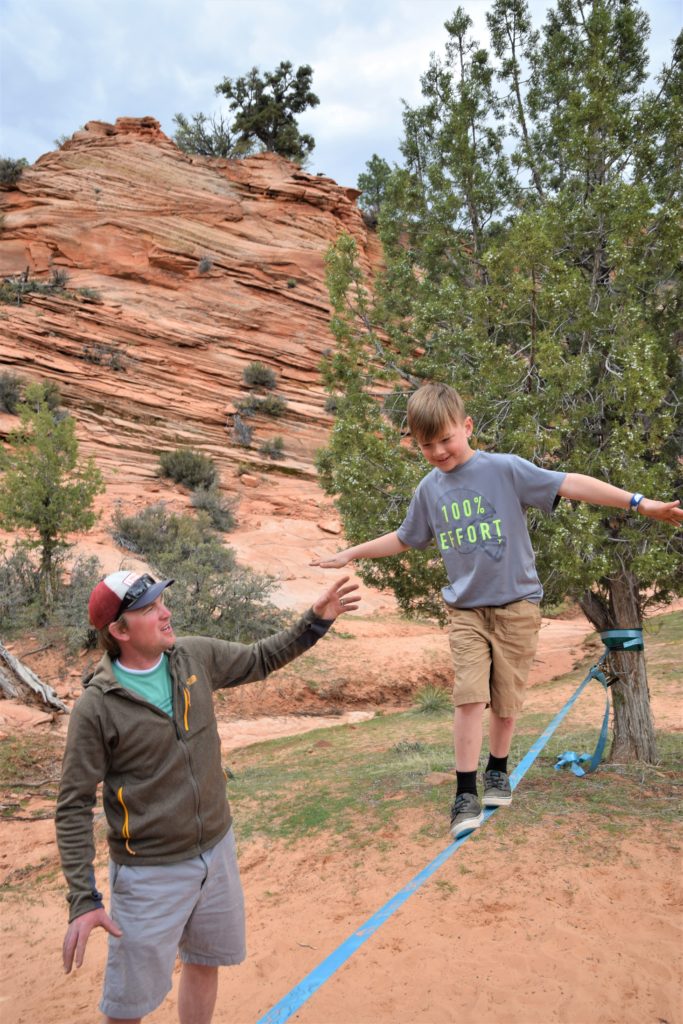
Slacklining is so much fun!
Cornhole Toss: Another crowd favorite and one of our favorite games to play while we are waiting for our dinner to cook at our campsite. We like this portable cornhole set because it makes for packing and storage. So fun! Here are some instructions on how to play cornhole.
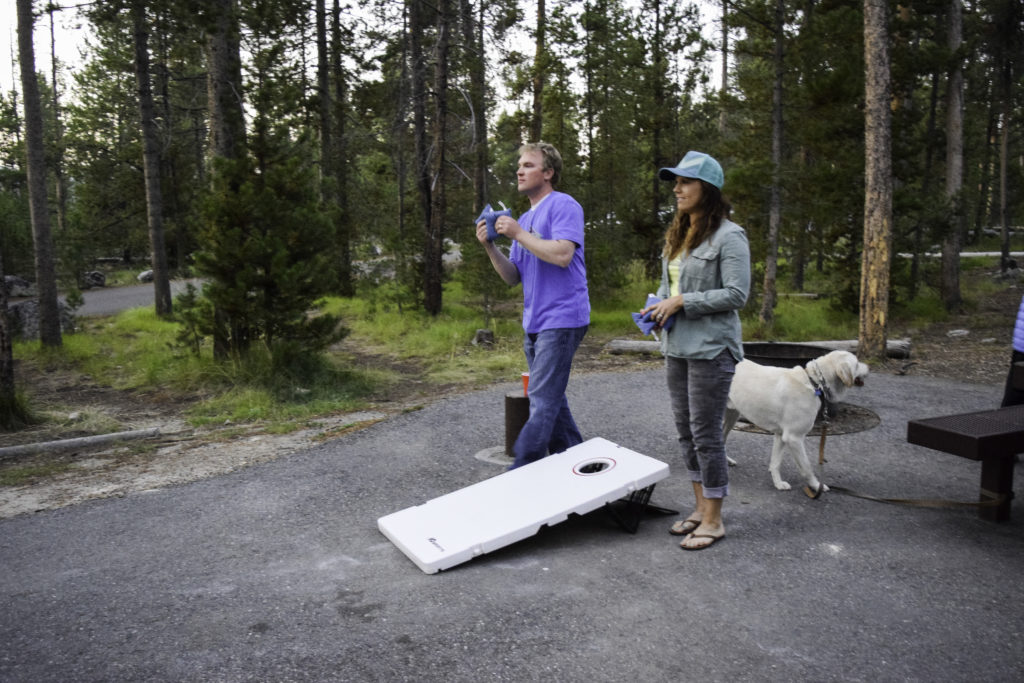
Playing a little cornhole while camping.
Glow Sticks: We love to go the dollar store (or you can buy a huge pack of assorted glow sticks on Amazon for cheap!) and use them for all sorts of things while we camp. Our favorite use for them is for glow-stick dance parties. All you need is a bunch of glow sticks of all different colors and tape! Just wait until dark and turn some music on!
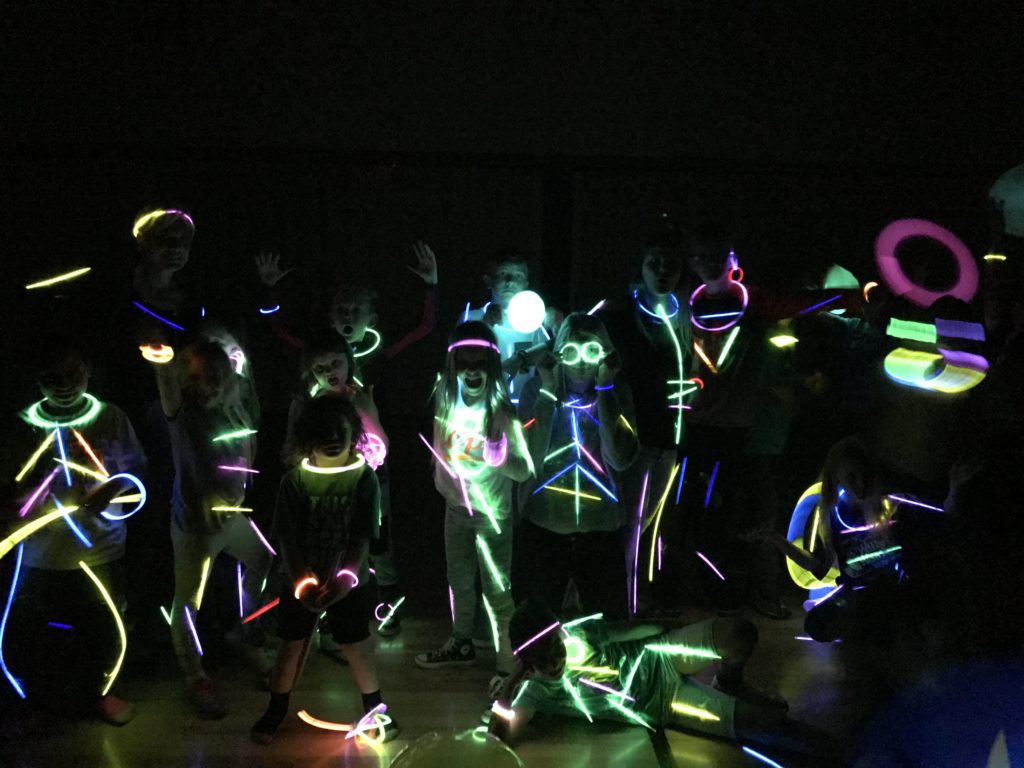
Glow stick dance party
You can use glow sticks for homemade lanterns in jars, or you can even use them for a glow-in-the-dark dinner!
Another fun way to use glow sticks is to break them open (adults should do this) and pour them into bubbles for glow-in-the-dark bubbles!
And lastly, you can use glow sticks for some neat night photography. To achieve the photo below, you need a good DSLR camera and a sturdy tripod set on a long exposure (settings should be f4.0, shutter speed 5 sec, ISO 200 or 400), and then just have each person stand still and while holding a glow stick trace a letter (of the word you want to spell) backwards over and over again for 5 sec (exposure time). Super easy and photos look so cool!
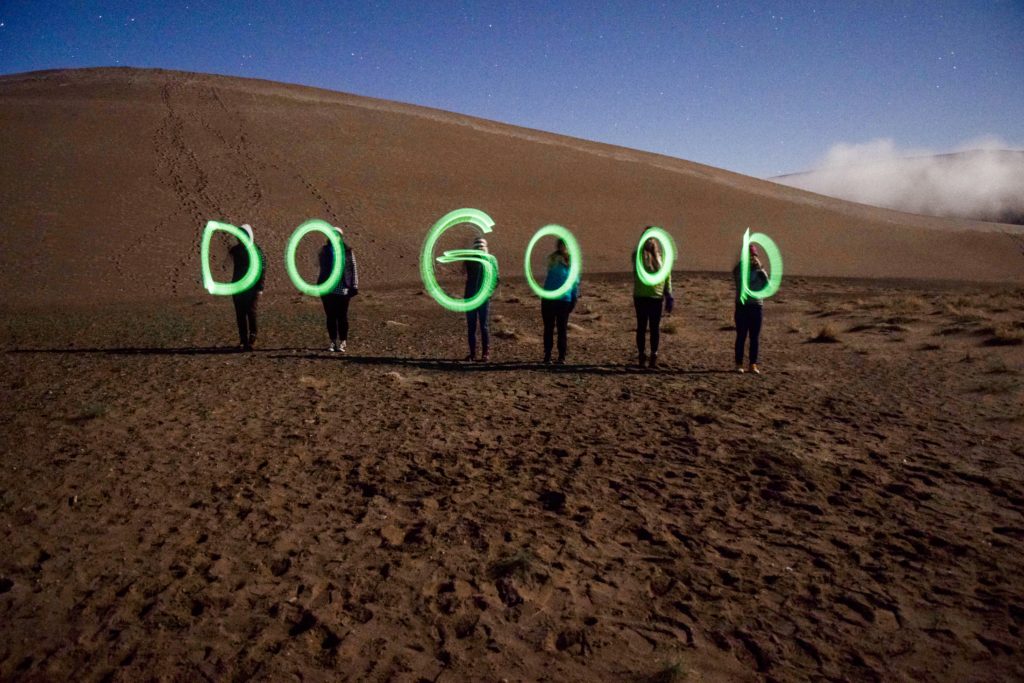
Glow stick night photography